

ΤΕΥΧΟΣ 127 ΑΠΡΙΛΙΟΣ-ΜΑΙΟΣ-ΙΟΥΝΙΟΣ 2024 ΤΡΙΜΗΝΙΑΙΑ ΕΚΔΟΣΗ ΝΑΥΤΙΚΟΥ ΜΟΥΣΕΙΟΥ ΤΗΣ ΕΛΛΑΔΟΣ ΜΑΡΙΝΑ ΖΕΑΣ - ΠΕΙΡΑΙΑΣ 185 37 Επιχορηγείται από ΥΠ.ΠΟ.-YEN-ΥΕΘΑ/ΓΕΝ-ΝΑΤ ΒΡΑΒΕΙΟ ΑΚΑΔΗΜΙΑΣ ΑΘΗΝΩΝ 2023
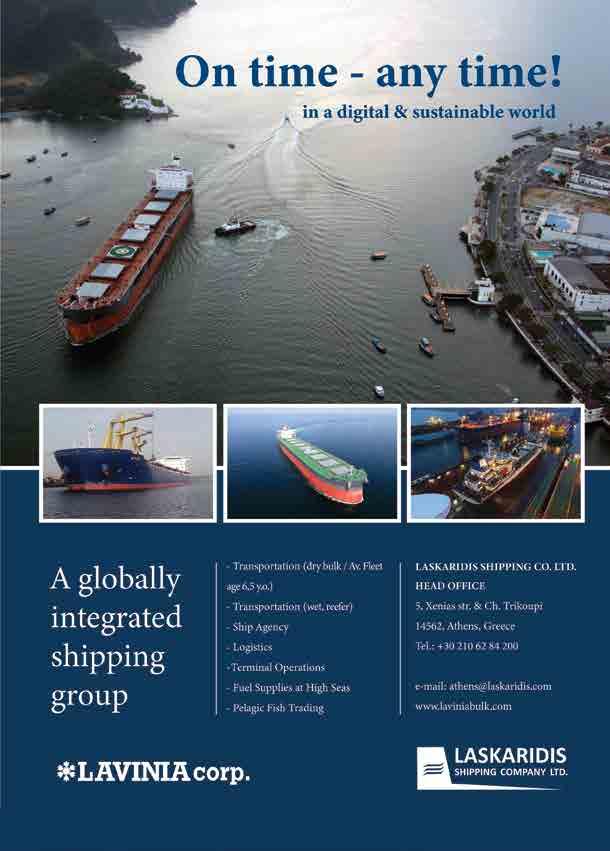


Εξώφυλλο Αγνώστου, Σφακτηρία Τέμπερα, 55x73 εκ. Συλλογή ΝΜΕ
Τριμηνιαία Έκδοση
2528
Ιδιοκτήτης:
Ζέας, Πειραιάς 185 37
Τηλ.: 210 45 16 264 • Fax: 210 45 12 277 E-mail: info@hmmuseum.gr, hellenicmaritimemuseum@gmail.com Website: www.hmmuseum.gr
Εκδότης - Διευθυντής:
Αναστασία Αναγνωστοπούλου-Παλούμπη Πρόεδρος
του Ναυτικού Μουσείου της Ελλάδος
Διεύθυνση Σύνταξης: Γιάννης Παλούμπης
Επιμέλεια Έκδοσης: Αναστασία Αναγνωστοπούλου-Παλούμπη
Πηνελόπη Βουγιουκλάκη
Δρ Βυζαντινής Αρχαιολογίας Ιωάννα Μπερμπίλη Μ.Δ.Ε. Βυζαντινής





Ναυτικού Μουσείου της Ελλάδος Κωδ.
του
Ναυτικόν
Μαρίνα
Μουσείον της Ελλάδος
Αρχαιολογίας & Διοίκησης Πολιτιστικών Μονάδων Διαφημίσεις: Ν. Νικολαΐδης-Ε. Σ. Σύρος Τηλ./Fax: 210 24 35 075 Γραμματεία: Κλεοπάτρα Ρηγάκη Εκτύπωση: ΕΥΑΓΓΕΛΟΣ ΣΤΕΡΓΙΟΥ Μον. ΙΚΕ ΔΙΑΝΕΜ Ε ΤΑΙ ΔΩΡ ΕΑ Ν Οι απόψεις που εκφράζονται στον ΠΕΡΙΠΛΟΥ είναι προσωπικές των συγγραφέων και δε δεσμεύουν το ΝΜΕ, ούτε ερμηνεύουν την πολιτική ή τις αποφάσεις του. 072/482020-74/ 127 30 16 38 05 ΝΑΥΤΙΚΟ ΜΟΥΣΕΙΟ ΤΗΣ ΕΛΛΑΔΟΣ HELLENIC MARITIME MUSEUM 25 - 29 25 - 29 www.hmmuseum.gr • • • • • 2023 02 04 07 16 30 38 52 65
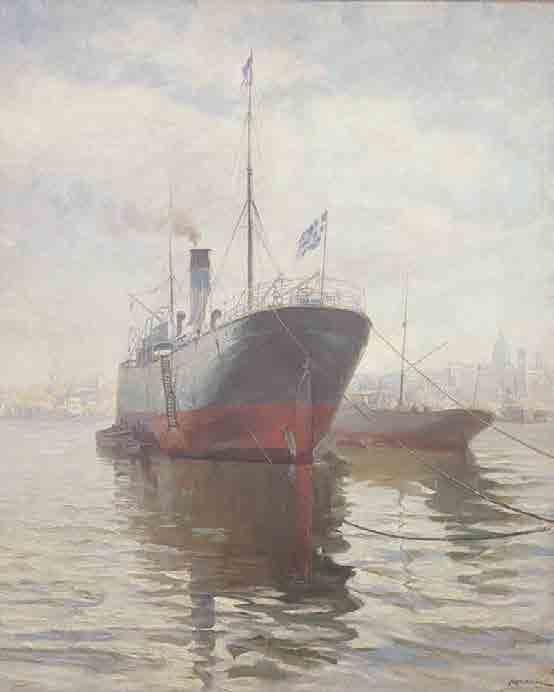
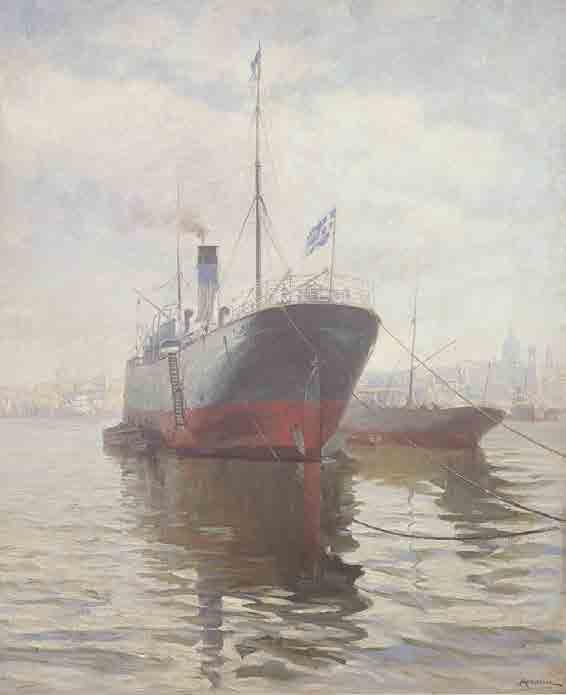
2
D be v Me S c u e b c eve e w c e v w v The w c v I h w v I v The The ve v ve v The ce h T I be T Y T I wish you have a nice summer. Anastasia Anagnostopoulou-Paloubi Τ 7 Posidonia 3-7 June 2024 3 D be v Me S c u e b c eve e w c e v w v The w c v I h w v I v The The ve v ve v The ce h T I be T Y T I wish you have a nice summer. Anastasia Anagnostopoulou-Paloubi Τ 7 Posidonia 3-7 June 2024 3
Anniversary issue

The Hellenic Maritime Museum has opened its doors to the public in 1949, the Museum continues to present and revitalize
dant exhibits, especially ship models, archaeo-
considerable import ance, within the expan-
This pu blication has been meticulously tailored to suit contemporary circumstances, enhanced over time, and serves as a stead-
The exhibition “ ”, under the auspic
--
-
-

Επετειακό τεύχος Χαιρετισµός Υπουργού Ναυτιλίας και Νησιωτικής Πολιτικής Ε
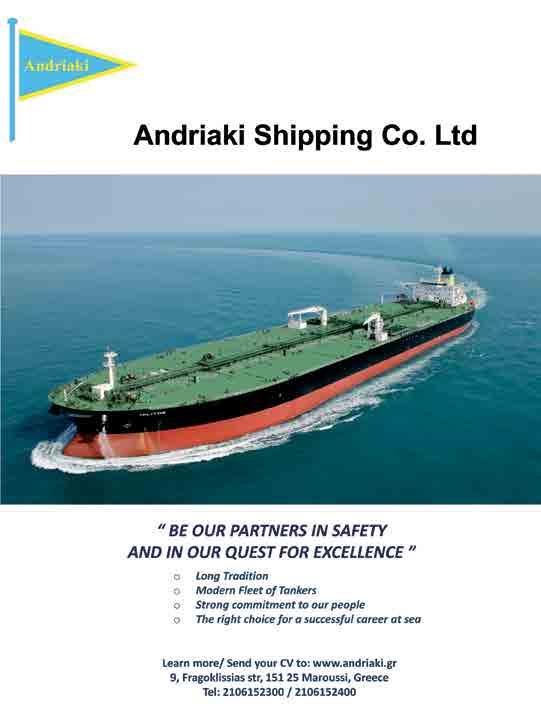
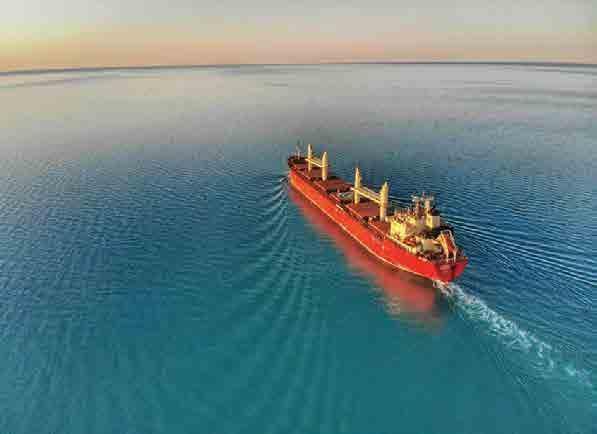
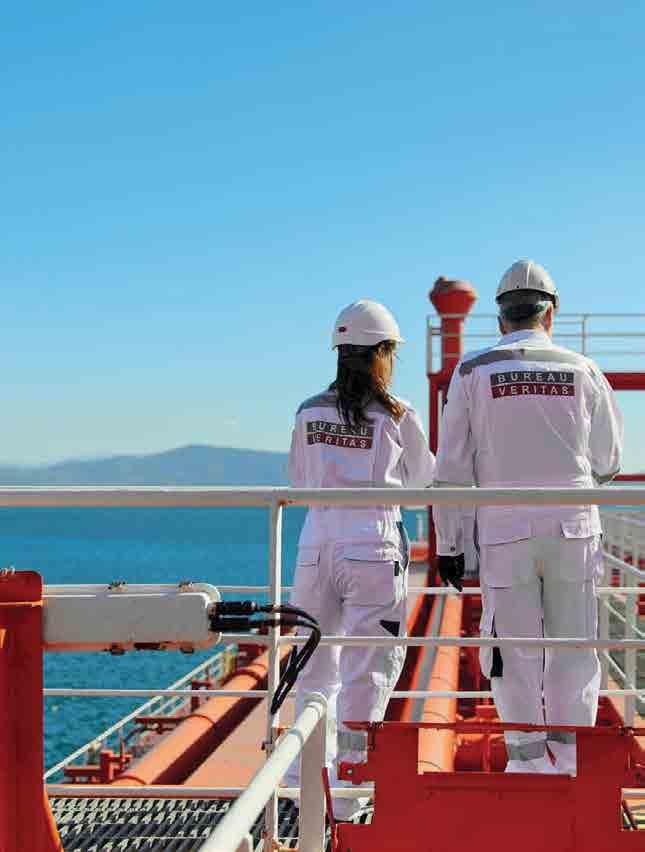

mise, we support clients worldwide with practical advice, tools

---
-
8

WE’RE BY YOUR SIDE
At Bureau Veritas, each and every one of us is by your side to help you navigate your decarbonization journey.
Supporting you with practical advice, tools and technology for you to make the right decisions for your business.
Learn more at marine-offshore. bureauveritas.com
Shaping a better maritime world.
Bureau Veritas was founded in 1828 to address marine risks. Our priority is safety - for our clients and society.
Today we are a multi-sector Testing, Inspection than 75,000 people world-wide and about 1,400 laboratory and testing facilities. e-mail:
The international shipping sector relies on marine insurance, which has a long history in Greece due to the country's extensive maritime trade. Maritime insurance in Greece has evolved greatly over the previous two centuries thanks to the of both local and international companies like the UK P&I Club and UK Defence Club. Greek maritime insurance has a lengthy history, but it wasn't until the 19th century that the industry became formally established. Although maritime operations were hindered during the Greek War of Independence (1821–1829), the shipping sector revived the establishment of the independent Greek state and disruptions to trading diminished.
the modern Greek state was established in 1830, there was a period of relative political and economic stability which allowed for an expansion of commercial activities, especially maritime trade and the associated insurance. Owners on the islands of Hydra, Spetses, Andros, and Chios emerged as the most prominent shipowners who expanded their and trade routes overseas. They were joined by the Greek diaspora, especially in the Western Europe, and the outskirts of the Ottoman Empire.
During the nineteenth century, Greek shipowners mostly looked to markets abroad, especially London, the biggest insurance hub in the world, and other markets, such us the Dutch, the German and the Italian. Domestic marine insurance companies began to establish themselves in the late 19th and early 20th centuries. These businesses aimed to provide Greek shipowners with insurance solutions that met their requirements so they would be less dependent on insurers based outside. However, the majority of Greek ships' marine insurance coverage was still underwritten in London. During the 19th century, and prior to the establishment of P&I Clubs, marine insurance primarily covered hull and machinery damage. However, this shipowners exposed to a range of third-party liabilities, which became with the growth of international trade and shipping. To meet this need, the P&I Clubs emerged from around1855, with the UK P&I Club amongst the earliest, in 1869. One of the risks covered by the new Clubs was collision liabilities, which were traditionally excluded by H&M underwriters. This then extended to cargo liabilities, crew claims and, towards the end of the 19th century, pollution liabilities. During the same period, the UK Defence Club was established in 1888 as a legal costs insurer and has since then, provided advice and guidance to Members in the management of their legal disputes.
Together, P&I, Defence and H&M insurances sit together to protect much of shipowners’ and vessel’s interests.
WWII, Greece's maritime sector again. Greek shipowners took advantage of favourable conditions to rapidly expand their elevating Greece to the ranks of the world's leading maritime nations. A more developed marine insurance industry was born out of this expansion in Greece.
The UK P&I Club and UK Defence Club have been engaged with the Greek shipping industry throughout this time. The clubs have an in Piraeus, the traditional heart of Greek maritime activity and has partnered with shipowners as they expanded their trade and navigated a changing world.
The 21st century has evidenced in global trading patterns, new laws, and new technologies. The digital revolution is an example, with a impact on the shipping industry as a whole. The UK P&I Club and UK Defence Club closely monitor developments, to provide guidance to Members, when cover and operations are impacted by new technologies, such as the increasing use of electronic bills of lading. Similarly, the UK P&I and UK Defence Club advise on international regulations, sanctions, emissions control, maritime biodiversity preservation and legal disputes arising from geopolitical risks . The UK P&I Club is an industry leader in the provision of loss prevention and guidance through its Risk and Safety Management services. The UK Defence Club is the world’s largest and leading Defence risks insurer.
The expansion of marine insurance in Greece over the past two centuries is evidence of the country's lengthy nautical heritage and its ability to adapt to changing global conditions. The UK P&I Club and UK Defence Club have has been part of this remarkable industry and will continue to work with owners as they respond to the challenges of the future.
10
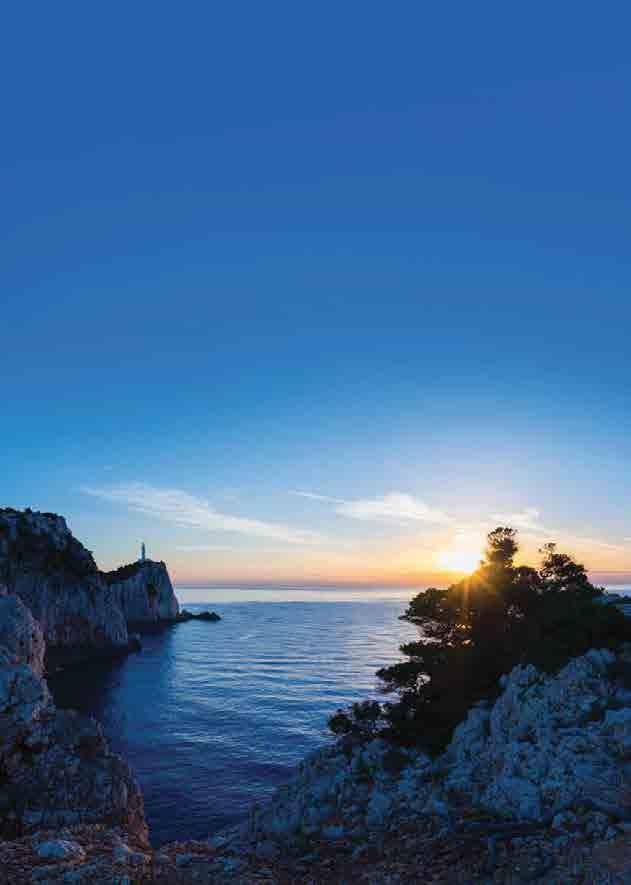
Leadingtheway




Το Νηολόγιο της Λιβερίας σήμερα. Μιά Παγκόσμια Δύναμη στη Ναυτιλία Ο ΠΕΙΡΑΙΑΣ 75 Χρόνια στην Υπηρεσία της Ελληνικής Ναυτιλίας 2024 Ιστορικό Νηολογίου Λιβερίας
– Το γραφείο του Πειραιά 12
LISCR HELLAS S.A.
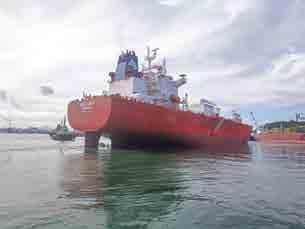
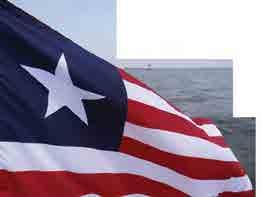


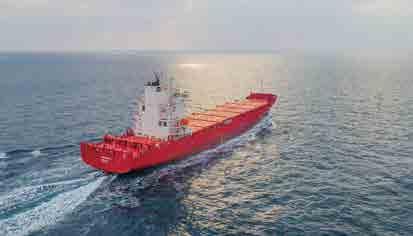
ALL FLAGS ARE NOT ALIKE 3-8 June 2024 The LIBERIAN REGISTRY Proudly Serving Greek Shipowners Since 1948

14
15
10,000 years of Hellenic Maritime Tradition
Pre-Historic Age. 8000 BC-1100 BC
THE BEGINNING
In the cave of Fraghthi, in Argolida, at a habitation stratum of 8,000 BC, excavations revealed scales of obsidian that were identi ed as coming from the island of Milos. Obsidian is a volcanic glassy stone, which was used for making tools and arms by the Stone Age people.
We can only speculate regarding the oating means that were used to transport the obsidian from Milos to the Greek mainland. According to the prevalent scienti c version, they must have used a boat made of papyrus, like the Cor ot papyrella.
The important fact, which is proven by the findings at Fraghthi, is that trading transactions and sea voyages in the Aegean had
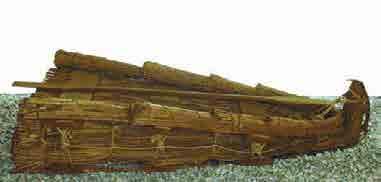
Cor ot papyrella. The papyrellas from Corfu were essentially shing boats and were in use, in west Corfu, until 1965. The boat’s primitive form and structure led researchers to believe that it is a residual of prehistoric maritime technology of eastern Mediterranean. H.M.M. collection.
Below: Earthenware “frying-pan” utensil with incised representation of a many –oared vessel. From Chalandriani, Syros. 2800-2300 BC. National Archaeological Museum, Athens. © Archaeological Receipts Fund.
already begun 10,000 years ago, and it is the most ancient trip, worldwide, that is evidenced by archaeological findings. The mild climatic conditions and the geographical formation of the Aegean islands o ered the most ideal conditions for the development of shipping. Very early on, the inhabitants of the Cyclades islands turned to the sea and pioneered in the skill of shipbuilding and seamanship, as it is evidenced by the rock paintings and engravings on vessels showing many – oared boats, from the 3rd millennium BC. In the Neolithic age, the Cycladic civilization was mainly a seafaring one and sea voyages were the main occupation of the people of the Cyclades islands.
THE MINOAN M ARI T I M E SUPRE M ACY

The early Cycladic civilization is succeeded by that one of Minoan Crete. The use of copper for making arms and tools proves longer trips outside the Aegean, to places like Cyprus, the Middle East, Egypt etc. Archaeological findings substantiate the establishment of colonies and naval stations by the Minoans, at the islands of the Aegean, the Greek mainland, the coast of Asia Minor and Phoenicia. The ceramic works of art of the Minoan civilization, at the palaces of Knossos, Phaestos, Zakros and Mallia ooded the area of the Near East and substantiate the discovery that Crete becomes the rst sea-ruling power in eastern Mediterranean. It monopolizes maritime commerce and its people experience a time of peace, creation and prosperity. The ships that were used by the Minoans are known to us from representations on vessels, jewellery and seals.
ΟΙ ΑΠΑΡΧΕΣ Στο σπήλαιο Φράγχθι της Αργολίδας σε στρώμα κατοίκησης του 8.000 π.Χ. οι ανασκαφές έφεραν στο φως φολίδες οψιδιανού που αναγνωρίσθηκαν ότι προέρχονταν από το νησί της Μήλου. Ο οψιδιανός είναι ηφαιστιογενές υαλώδες πέτρωμα το οποίο οι άνθρωποι της εποχής του λίθου χρησιμοποιούσαν για την κατασκευή εργαλείων και όπλων. Μόνο υποθέσεις μπορούμε να κάνουμε για τα πλωτά μέσα που χρησιμοποιήθηκαν για τη μεταφορά του οψιδιανού από τη Μήλο στην ηπειρωτική Ελλάδα. Σύμφωνα με την επικρατέστερη επιστημονική εκδοχή πρέπει να είχε χρησιμοποιηθεί ένα παπυρένιο σκάφος κατά το πρότυπο της κερκυραϊκής παπυρέλλας. Το σημαντικό γεγονός που αποδεικνύεται από τα ευρήματα του
Προϊστορική Εποχή. 8000 π.Χ.-1100 π.Χ.
Φράγχθι, είναι ότι οι εμπορικές συναλλαγές και τα θαλασσινά ταξίδια στα νερά του Αιγαίου πελάγους είχαν ήδη αρχίσει πριν από 10.000 χρόνια, και είναι παγκοσμίως, το αρχαιότερο ταξίδι που τεκμηριώνεται από αρχαιολογικά ευρήματα. Οι ήπιες κλιματολογικές συνθήκες και η γεωγραφική διαμόρφωση των νησιών του Αιγαίου προσέφεραν τις ιδανικότερες συνθήκες για την ανάπτυξη της ναυσιπλοΐας. Οι κάτοικοι των νησιών των Κυκλάδων στράφηκαν από πολύ νωρίς στη θάλασσα και πρωτοπόρησαν στην τέχνη του ναυπηγού και του ναυτίλου, όπως αποδεικνύουν οι βραχογραφίες και τα χαράγματα με απεικονίσεις πολύκωπων πλοιαρίων σε σκεύη της 3ης χιλιετίας π.Χ. Ο Κυκλαδικός πολιτισμός της νεολιθικής εποχής ήταν κυρίως ναυτικός και τα ταξίδια αποτέλεσαν την κύρια απασχόληση των Κυκλαδιτών. ΜΙΝΩΙΚΗ ΘΑΛΑ ΣΣΟ ΚΡΑΤΟ Ρ Ι Α Τον πρώιμο Κυκλαδικό ναυτικό πολιτισμό διαδέχεται ο πολιτισμός της Μινωικής Κρήτης. Η χρήση του χαλκού για την κατασκευή όπλων και εργαλείων, υπαγορεύει μεγαλύτερα ταξίδια και εκτός του Αιγαίου, στην Κύπρο, στη Μέση Ανατολή, στην Αίγυπτο. Αρχαιολογικά ευρήματα τεκμηριώνουν την ίδρυση αποικιών και ναυτικών σταθμών των Μινωιτών στα νησιά του Αιγαίου, στην ηπειρωτική Ελλάδα, στα παράλια της Μικράς Ασίας και της Φοινίκης. Τα κεραμικά τεχνουργήματα του Μινωικού πολιτισμού των ανακτόρων της Κνωσσού, της Φαιστού, της Ζάκρου, των Μαλλίων κατακλύζουν τον χώρο της Εγγύς Ανατολής και τεκμηριώνουν τη διαπίστωση ότι η Κρήτη γίνεται η πρώτη θαλασσοκράτειρα δύναμη στην ανατολική Μεσόγειο. Μονοπωλεί το ναυτικό εμπόριο και η κοινωνία της ζει μέρες ειρηνικές, δημι-
Αριστερά: Κερκυραϊκή παπυρέλλα. Συλλογή Ν.Μ.Ε. Οι κερκυραϊκές παπυρέλλες ήταν αλιευτικά κυρίως σκάφη και βρίσκονταν σε χρήση στη δυτική Κέρκυρα μέχρι το 1965. Η πρωτόγονη μορφή και κατασκευή του σκάφους οδήγησε τους ερευνητές στη σκέψη ότι πρόκειται για ένα κατάλοιπο της προϊστορικής ναυτικής τεχνολογίας της ανατολικής Μεσογείου. Left:
Kάτω: Πήλινο τηγανόσχημο σκεύος με εγχάρακτο πολύκπο πλοίο. Από τη Χαλανδριανή της Σύρου. 2800-2300 π.Χ. Αθήνα, Εθνικό Αρχαιολογικό Μουσείο. © Ταμείο Αρχαιολογικών Πόρων.
Ελληνική Ναυτική Παράδοση 10.000 χρόνων
16
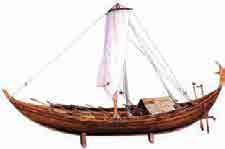
Αριστερά: Μινωικό πλοίο (1700-1400 π.Χ.). Ομοίωμα. Κατασκευή:
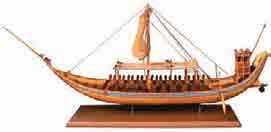
Left: Minoan ship (1700-1400 BC). Model by George and Aristotle Rallis. H.M.M. collection. Δεξιά: Πλοίο της Θήρας (17ος αι.
Right: Ship from Thira (17th century BC). Replica. Construction: George Rallis. H.M.M. collection.
In the eld of the shipbuilding, all the accumulated experience from the long, for that time, sea voyages, reached a peak in the middle of the 2nd millennium. The most signi cant evidence, regarding the progress in the eld of shipbuilding, in the Aegean of the copper era, is the representation of the so-called “ eet” on the wall paintings, at West House in Thira (Santorin), island dating back to about 1550 BC.
On the fresco, there are 14 small boats that form a “convoy” and use all the ways of propulsion, known at the time. Those boats have a ship-building perfectness. According to scholars, the length of these ships was, in actual fact, over 30 meters, they had 18 to 21 oars-men and there were two steering oars from both sides of the stern. The rich physiocratic decoration of the ships, on the wall painting, which is considered to be of an emblematic character, is also typical.

THE MYCENAEAN ASCENDANCY
1770. A steatite seal stone showing a sailing ship. Middle-Minoan IIB, 1800-1700 BC. Archaeological Museum, Heraklion, 1770.
From 1450 BC onwards, the Mycenaean’s succeed the Minoans in the ruling of the sea, establishing commercial networks in almost the whole of the Mediterranean basin. Their maritime accomplishments are re ected in Homer’s epics and the mythical maritime exploits of the Argonauts.
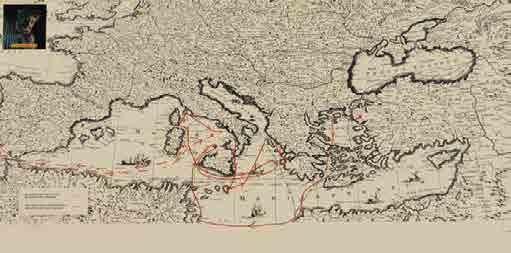
Map on which are drawn the routes taken by the Argonauts and Homer’s Ulysses. H.M.M. collection.
ουργίας και ευημερίας. Τα πλοία που χρησιμοποίησαν οι Μινωίτες, μας είναι γνωστά από απεικονίσεις σε αγγεία, κοσμήματα και σφραγίδες. Στον τομέα της ναυπηγικής τέχνης, όλη η συσσωρευμένη εμπειρία των μακρινών, για την εποχή, θαλασσινών ταξιδιών κορυφώνεται στα μέσα της 2ης χιλιετίας. Η σημαντικότερη μαρτυρία για την πρόοδο στον τομέα της ναυπηγικής, στο Αιγαίο της εποχής του χαλκού, είναι η παράσταση του αποκαλούμενου «στόλου» στις τοιχογραφίες της Δυτικής Οικίας της Σαντορίνης που χρονολογείται περίπου στο 1550 π.Χ. Στην τοιχογραφία απεικονίζονται 14 πλοιάρια που σχηματίζουν «πομπή» και χρησιμοποιούν όλους τους τότε γνωστούς τρόπους πρόωσης. Τα σκάφη αυτά παρουσιάζουν ναυπηγική αρτιότητα. Σύμφωνα με τους μελετητές, το μήκος αυτών των πλοίων στην πραγματικότητα ξεπερνούσε τα 30 μέτρα, διέθεταν από 18 έως 21 κωπηλάτες και υπήρχαν δύο πηδάλια στην πρύμνη. Χαρακτηριστικός επίσης είναι ο πλούσιος φυσιοκρατικός διάκοσμος των πλοίων της τοιχογραφίας, που θεωρείται εμβληματικού χαρακτήρα. Η ΜΥΚ Η ΝΑΪΚΗ Ε ΠΕΛΑ ΣΗ Από το 1450 π.Χ. οι Μυκηναίοι διαδέχονται τους Μινωίτες στην κυριαρχία της θάλασσας και εγκαθιδρύουν εμπορικά δίκτυα σχεδόν σε ολόκληρη τη Μεσογειακή λεκάνη. Τα ναυτικά τους επιτεύγματα απηχούνται στα ομηρικά έπη και στα μυθικά ναυτικά κατορθώματα των Αργοναυτών.
Σφραγιδόλιθος από στεατίτη από τα Μάλλια της Κρήτης με παράσταση πλοίου με ιστίο. Μεσομινωική ΙΙΒ περίοδος, 1800- 1700 π.Χ. Ηράκλειο, Αρχαιολογικό Μουσείο
Γεώργιος και Αριστοτέλης Ράλλης.
π.Χ.).
Κατασκευή: Γεώργιος Ράλλης. Συλλογή Ν.Μ.Ε.
Χάρτης με αναπαράσταση των πιθανών πορειών που ακολούθησαν οι Αργοναύτες και ο Ομηρικός Οδυσσέας. Συλλογή Ν.Μ.Ε.
17
Συλλογή Ν.Μ.Ε.
Ομοίωμα.

In the 12th century BC, the invasion of new populations in the Greek territory, signi ed the end of Mycenaean world. The subsequent centuries are an era of intense procedures and upheavals, when the foundations for the development and formation of the succeeding classical Greek civilization are being established. Depictions of ships, in representations on vessels, are increasing in number, dating back to the end of this period. It is the time when the Greek tribes are moving, establishing colonies in all the coasts of the Mediterranean, from Marseille in France, to the coast of the Black Sea.
The ships’ displacement increases, as it is revealed by the increasing number of the oarsmen, portrayed. From Homer’s descriptions, concerning ships of the 8th century BC, we understand that there were many kinds of ships, while the emerging distinction of ships as merchant or warships is a very important development. It is then that the triantakontors (with 15 oars on either side) and the pentikontors (with 25 oars on either side) appear that were the forerunners of the war ships in the classical period.

Geometrical Attic
from Thebes showing a war ship and an “abduction” scene. It probably refers to the abduction of Helen of Troy by Paris or of Ariadne by Theseus. 735-710 BC. British Museum, London, 1899, 2-19. Δεξιά:
(7ος
Right: Pentekonter (7th century BC). Replica. Construction: G. Vammenos. Supervision: K. Alexandris. H.M.M. collection.
In the 7th century BC, the rst triremes were built. The trireme is considered to be the masterpiece of the Greeks’ ancient, shipbuilding skill. She has three rows of oars on each side (a total of 170) and a crew of about 200 men. The trireme had the rst, pure naval weapon in history, the rammer. It was a strong, metal, sharp end of the keel, at the ship’s bow, which was used for ramming and breaking the opponent’s hull. The trireme will dominate, in the 2nd half of the last millennium before Christ, and she is the ship that will save Western civilization at the sea battle of Salamis in 480 BC from the mortal danger of the Persians.

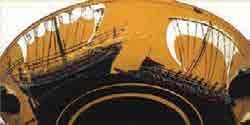
Τον 12ο π.Χ αιώνα στον ελληνικό χώρο οι εισβολές νέων πληθυσμών σημαίνουν το τέλος του μυκηναϊκού κόσμου. Οι επόμενοι αιώνες είναι μιά εποχή έντονων διεργασιών και ανακατατάξεων, όπου τίθενται οι βάσεις για την ανάπτυξη και διαμόρφωση του διαδόχου κλασικού ελληνικού πολιτισμού. Οι απεικονίσεις πλοίων πληθαίνουν σε παραστάσεις αγγείων, που χρονολογούνται στο τέλος αυτής της περιόδου. Είναι η εποχή που τα ελληνικά φύλα μετακινούνται και ιδρύουν αποικίες σε όλα τα παράλια της Μεσογείου από τη Μασσαλία της Γαλλίας, μέχρι τις ακτές της Μαύρης Θάλασσας. Το εκτόπισμα των πλοίων μεγαλώνει, όπως αποκαλύπτει ο αυξανόμενος αριθμός των απεικονιζομένων κωπηλατών, ενώ από τις ομηρικές περιγραφές που αφορούν τα πλοία του 8ου αιώνα π.Χ. καταλαβαίνουμε πως υπήρχαν πολλά είδη πλοίων, ενώ πολύ σημαντική εξέλιξη είναι η διαφαινόμενη διάκριση των πλοίων σε εμπορικά και πολεμικά. Τότε εμφανίζονται οι τριακόντοροι (με 15 κουπιά σε κάθε πλευρά) και οι πεντηκόντοροι (με 25 κουπιά σε κάθε πλευρά), πρόδρομοι των πολεμικών πλοίων τη κλασικής εποχής.
Γεωμετρική Εποχή. 1100 π.Χ.-700 π.Χ. Geometric Period. 1100 BC- 700 BC Τον 7ο αιώνα π.Χ. ναυπηγούνται οι πρώτες τριήρεις. Η τριήρης θεωρείται το αριστούργημα της αρχαίας ναυπηγικής τέχνης των Ελλήνων. Έχει τρεις σειρές κουπιών σε κάθε πλευρά (συνολικά 170) και πλήρωμα περίπου 200 ανδρών. Η τριήρης διέθετε το πρώτο στην ιστορία αμιγώς ναυτικό όπλο, το έμβολο. Αποτελούσε μια ισχυρή μεταλλική πρωραία απόληξη της τρόπιδας που χρησιμοποιείτο για τον εμβολισμό και τη διάρρηξη του αντιπάλου σκάφους. Το πλοίο αυτό θα κυριαρχήσει στο 2ο μισό της τελευταίας προ Χριστού χιλιετίας, και είναι εκείνο που θα σώσει τον Δυτικό πολιτισμό από τον θανάσιμο κίνδυνο του περσικού εναγκαλισμού,
Αρχαϊκή-Κλασική-Ελληνιστική Εποχή. 700 π.Χ.-146 π.Χ.
Period. 700 BC-146 BC
Γεωμετρικός αττικός κρατήρας από τη Θήβα με πολεμικό πλοίο και σκηνή «απαγωγής». Πιθανόν πρόκειται για την αρπαγή της ωραίας Ελένης από τον Πάρι ή της Αριάδνης από τον Θησέα. 735-710 π.Χ. Λονδίνο, Βρετα-νικό Μουσείο 1899, 2-19.
crater
Πεντηκόντορος
αιώνας π.Χ.). Ομοίωμα. Κατασκευή: Γ. Βαμμένος. Εποπτεία: Κ. Αλεξανδρής. Συλλογή Ν.Μ.Ε.
Archaic-Classical-Hellinistic
Αριστερά:
Left:
Αριστερά: Μαρμάρινο ανάγλυφο γνωστό ως ανάγλυφο Lenormant με παράσταση τριήρους (λεπτομέρεια). 410-400 π.Χ. Αθήνα, Μουσείο Ακροπόλεως. © Ταμείο Αρχαιολογικών Πόρων. Left: Marble relief, known as the “Lenormant relief”, depicting a trireme (detail). 410-400 BC. Acropolis Museum, Athens. © Archaeological Receipts Fund. Δεξιά: Αττική μελανόμορφη κύλικα με παράσταση εμπορικού και πολεμικού πλοίου (λεπτομέρεια). Γύρω στο 510 π.Χ. Λονδίνο, Βρετανικό Μουσείο Β436. Right: Attic black- gure kylix showing a merchant and a war ship (detail). About 510 BC. British Museum B436, London. 18







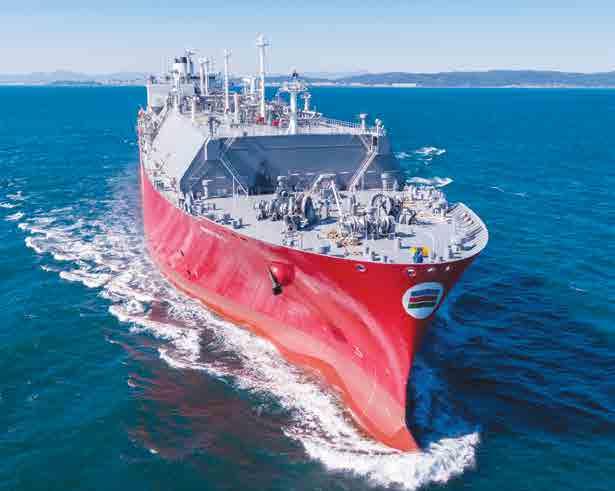
Capital Product Partners L.P. 3 Iassonos St., Piraeus 18537, Greece Tel: +30 210 4584950 www.capitalpplp.com, info@capitalpplp.com Share our Passion for Shipping! Capital Product Partners L.P. 3 Iassonos St., Piraeus 18537, Greece Tel: +30 210 4584950 www.capitalpplp.com, info@capitalpplp.com Share our Passion for Shipping!
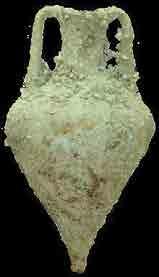
However, if the trireme ensures the ruling of the Mediterranean by the Greeks, the ship that carries supplies and spreads the Greek language, art and civilization, in general, is the olkas, the transport ship of the ancient world.
History flowed over Greece, the cities –states declined and all of the Greeks were united, for the fist time, under the rule of Phillip II, King of Macedonians. Then, Alexander the Great with his conquests and his descendants made Eastern Mediterranean a Greek sea. The ships’ range continuously increases, overseas trade is expanded and people are travelling to distant places, in order to widen their knowledge about the world and then to record it, so that their experiences from their voyages to new places could be utilized by subsequent generations.
At that time, ships are being perfected and trips are far better organized. A lot of information, regarding ship-building and commercial ships of the classic period, is given to us by the wooden ship, preserved by 75%, which was found at the bottom of the sea of Cyrene, in Cyprus and dated, accurately, as going back to 303 BC. She was made of pine tree, according to the ancient shipbuilding technique, by which the shell was structured rst and then the frame. She was 15 meters long and when she was sunk, she carried 403 amphorae with wine from Rhodes, sacks of almonds and 29 millstones.
Over the following centuries, when the world’s ruling goes to the Romans, the Greeks’ sea trading activities do not stop. Greek seamen, being more experienced, carry out the internal and external trade of the Roman Empire, man its war ships and the in uence of the Greek ship-building mastery on the roman ship is obvious.
The ports of many Greek cities, like Salonica, Nikopolis, Delos, Rhodes and others, have a new period of prosperity, under Roman rule.
Πάνω:
Ν.Μ.Ε. Above: Pointed amphorae from Corfu. 3rd century BC. Height: 73 cm. H.M.M. collection.
Κάτω:
9514. Below: View of an Italian port. Fresco from Stabiae, 1st century. National Archaeological Museum 9514, Naples.
G. Bass. Right: The ancient shipwreck that was raised and restored in Kyrenia Castle, Cyprus. G. Bass archives.
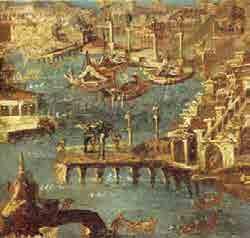

στην ναυμαχία της Σαλαμίνας το 480 π.Χ. Αν όμως η τριήρης εξασφαλίζει την ηγεμονία των Ελ λήνων στη Μεσόγειο, το πλοίο που μεταφέρει προ ϊόντα και διαδίδει την ελληνική γλώσσα, τέχνη και εν γένει πολιτισμό, είναι η ολκάδα, το μεταφορικό πλοίο του αρχαίου κόσμου. Η ιστορία κύλησε πάνω από την Ελλάδα, οι πόλεις –κράτη παρήκμασαν και όλοι οι Έλληνες για πρώ τη φορά ενώθηκαν υπό την ηγεμονία του Φιλίπ που Β’ Βασιλιά των Μακεδόνων. Στη συνέχεια ο Μέγας Αλέξανδρος με τις κατακτήσεις του και οι επίγονοί του μετέτρεψαν την Ανατολική Μεσόγειο σε ελληνική θάλασσα. Η ακτίνα ενέργειας των πλοίων μεγαλώνει συνεχώς, το υπερπόντιο εμπόριο επεκτείνεται και οι άνθρωποι ταξιδεύουν σε μακρινά μέρη για να διευρύνουν τις γνώσεις τους για τον κόσμο και εν συνεχεία να τις κατάγραψουν, ώστε οι εμπειρίες τους από τα ταξίδια σε νέα μέρη να αξιοποιηθούν από τις επόμενες γενιές. Τα πλοία σε αυτή την εποχή τελειοποιούνται και τα τα ξίδια είναι πιο καλά οργανωμένα. Πολλές πληροφορίες για τη ναυπηγική τέχνη και τα εμπορικά πλοία της κλασ σικής εποχής μας έδωσε το διατηρημένο κατά 75% ξύλινο σκαρί πλοίου που βρέθηκε στο βυθό της Κυρήνειας της Κύ πρου και χρονολογήθηκε με ακρίβεια ότι ανάγεται στο 303 π.Χ. Είχε κατασκευαστεί από ξύλο πεύκου, κατά την αρχαία ναυπηγική τεχνική, σύμφωνα με την οποία φτιάχνονταν πρώτα το πέτσωμα (shell rst) και μετά τοποθετούνταν οι νομείς. Είχε 15 μέτρα μήκος και μετέφερε, όταν βυθίστηκε, 403 αμφορείς με κρασί από τη Ρόδο, σακιά με αμύγδαλα και 29 μυλόπετρες. Στους αιώνες που θα ακολουθήσουν όταν η κυριαρχία του κόσμου περνά στους Ρωμαίους, η θαλασσινή εμπορική δραστηριότητα των Ελλήνων δεν σταματά. Οι Έλληνες ναυτικοί, πιο έμπειροι διεξάγουν το εσωτερικό και εξωτερικό εμπόριο της Ρωμαϊκής Αυτοκρατορίας, επανδρώνουν τα πολεμικά της πλοία και η επίδραση της ελληνικής ναυπηγικής τέχνης στο ρωμαϊκό πλοίο είναι εμφανής. Νέα εποχή ακμής, υπό την κυριαρχία των Ρωμαίων, γνωρίζουν πολλά λιμάνια ελληνικών πόλεων, όπως η Θεσσαλονίκη, η Νικόπολη, η Δήλος, η Ρόδος, κ.α.
Οξυπύθμενος αμφορέας από την Κέρκυρα.
π.Χ.
Συλλογή
3ος.
Yψος: 73εκ.
Άποψη ιταλικού λιμανιού. Τοιχογραφία από τους Σταβίους, 1ος αι. Νεάπολη,
Αρχαιολογικό
Εθνικό
Μουσείο
αρχαίο ναυάγιο που ανασύρθηκε και αποκαταστάθηκε στο Κάστρο της Κυρήνειας της Κύπρου.
20
Δεξιά: Το
Αρχείο

Sailing in the byzantine seas. The paths of sea trade
The advantageous geographical position of the Byzantine Empire –at the crossroad between East and West– very early on, made it a world trade center. For a long period of time, the Byzantines maintained control over the Mediterranean and held a leading role in maritime trading transactions.
THE BYZ AN T INES RULERS OF T HE MEDI T ERRANEAN
In the early Byzantine era, especially during the 5th and 6th centuries AD, the Empire’s eastern provinces played a particularly signi cant role in commerce. The most important trading routes, through which all merchandise and raw materials were transferred, from the Far East towards the Mediterranean, ended up in Antioch and Alexandria, the large trading centers of Syria and Egypt. From there, the ships undertook to spread them to all the important ports of the Mediterranean and support the people that lived there. Signi cant coastal centers, like the Peloponnese and the Ionian islands, were used as intermediary stations along the trading routes from Italy towards Constantinople, Asia Minor and the Palestine.
THE A RABIAN IN T ERFERENCE
When the Arabs regained the Empire’s eastern provinces, the Byzantine state sought new trading bases. At that time, the center of commercial activities was transferred to the Greek territory and the Black Sea ports. Constantinople still remained the key to transit trade, while, at the same time, Salonika developed into an important trading junction.
THE INFILT RAT ION OF T HE ITALIAN CI T IES
IN TO T HE E AS T MEDI T ERRANEAN T RADE
At the end of the 11th century, the commercial eets of the Italian cities began to penetrate the East trade and gradually establish their rule. The territorial acquisitions and the colonies, that were established by the Italian seafaring communities, within Byzantine territory, like those at Galatas, Ka as, Crete and Euboea, were the indisputable factor, which contributed to their taking over the control of the Eastern Mediterranean commerce and to the isolation of the Byzantine traders.
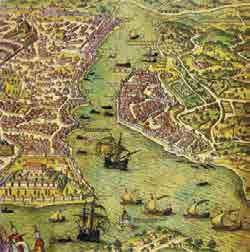
During the time of the Palaeologos dynasty (1261-1453), the role of the Byzantines in the East transit trade has diminished, but not extinguished. The Byzantines continued to trade in the Aegean and the Black Sea, where tradesmen begin to appear from Constantinople, Adrianople, Salonika, Mistras and Monemvasia.
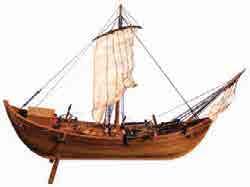
Hogenberg,
Left: Constantinople and the Golden Horn bay. Engraving by Braum and Hogenberg. 16th century. Gennadius Library.
Above:
Αριστερά: Κωνσταντινούπολη και Κεράτιος κόλπος. Χαρακτικό των Braum και
16ος αι. Γεννάδειος Βιβλιοθήκη.
Πάνω: Βυζαντινό εμπορικό πλοίο (7ος αι. μ.Χ.). Ομοίωμα. Κατασκευή: Αρ. Ράλλης. Συλλογή Ν.Μ.Ε.
century
Ηπρονομιακή γεωγραφική θέση του βυζαντινού κράτους –σταυροδρόμι ανάμεσα σε Ανατολή και Δύση– το κατέστησε από πολύ νωρίς κομβικό σημείο του διεθνούς εμπορίου. Οι Βυζαντινοί για μεγάλο χρονικό διάστημα διατήρησαν τον έλεγχο της Μεσογείου και πρωταγωνίστησαν στις θαλάσσιες εμπορικές συναλλαγές. ΟΙ ΒΥΖΑΝΤΙΝ ΟΙ ΚΥΡ Ι ΑΡΧΟ Ι Τ Η Σ Μ ΕΣΟΓΕΙΟ Υ Κατά τους πρωτοβυζαντινούς χρόνους, κυρίως τον 5ο και 6ο αι. μ.Χ., οι ανατολικές επαρχίες της αυτοκρατορίας ήταν εκείνες που διαδραμάτισαν ιδιαίτερα σημαντικό ρόλο στο εμπόριο. Oι κυριότερες εμπορικές αρτηρίες από τις οποίες διακινούνταν τα εμπορεύματα και οι πρώτες ύλες της Άπω Ανατολής προς τη Μεσόγειο κατέληγαν στα μεγάλα εμπορικά κέντρα της Συρίας και της Αιγύπτου, την Αντιόχεια και την Αλεξάνδρεια. Από εκεί τα πλοία αναλάμβαναν να τα διασπείρουν σε όλα τα σημαντικά λιμάνια της Μεσογείου και να τροφοδοτήσουν τους πληθυσμούς που κατοικούσαν εκεί. Σημαντικά παραθαλάσσια κέντρα, όπως η Πελοπόννησος και τα Ιόνια νησιά αποτέλεσαν τους ενδιάμεσους σταθμούς των εμπορικών διαδρομών από την Ιταλία προς την Κωνσταντινούπολη, τη Μικρά Ασία και την Παλαιστίνη. Ο Α ΡΑ Β ΙΚΟ Σ ΑΝΤΑ ΓΩΝΙ ΣΜΟ Σ Όταν οι Άραβες ανέκτησαν τις ανατολικές επαρχίες της Αυτοκρατορίας το βυζαντινό κράτος αναζήτησε νέες εμπορικές αφετηρίες. Το κέντρο των εμπορικών δραστηριοτήτων μετατέθηκε τότε στον ελλαδικό χώρο και τα λιμάνια του Ευξείνου Πόντου. Η Κωνσταντινούπολη παρέμεινε το κλειδί του διαμετακομιστικού εμπορίου, ενώ την ίδια περίοδο η Θεσσαλονίκη αναπτύχθηκε σε σημαντικό εμπορικό κόμβο. Η ΔΙ ΕΙΣ ΔΥ ΣΗ ΤΩΝ ΙΤΑΛΙΚ Ω Ν Π ΟΛ Ε ΩΝ Σ ΤΟ ΕΜ Π Ο ΡΙ Ο Τ Η Σ Α ΝΑΤΟΛΙΚΗΣ Μ ΕΣΟΓΕΙΟ Υ Στα τέλη του 11ου αιώνα οι εμπορικοί στόλοι των ιταλικών πόλεων άρχισαν να διεισδύουν στο εμπόριο της Ανατολής και σταδιακά να εδραιώνουν την κυριαρχία τους. Οι εδαφικές κτήσεις και οι εμπορικές αποικίες, που οι ναυτικές ιταλικές κοινότητες δημιούργησαν στα βυζαντινά εδάφη, όπως στον Γαλατά, στον Καφ-φά, στην Κρήτη και στην Εύβοια ήταν και ο αδιαμφισβήτητος παράγοντας που συ22
Byzantine merchant ship (7th
A.D.). Model by Aristotle Rallis. H.M.M. collection.
(shell rst). Right: Caique from Inepolis with sakoleva sail rigging. Scale: 1/30. Model by Aristotle Rallis. Research and drawings: F.E.Paris, K. Damianidis. H.M.M. collection. In the area of Inepolis, on the coast of the Black Sea, the ancient technique of ship-building (shell rst) survived until the beginning of the 20th century.
Below: Earthenware pithos (jar) of the byzantine period, for transporting wine (detail). The vessel features incised representations of a merchant ship and a dromon (warship). From Euboea. H.M.M. collection.
THE SHIPS
Information regarding the trading ships, during the Byzantine period, comes mainly from marine archeology ndings, as well as from the limited number of representations. The shipwreck of a small, 7th century trading boat, near the islet of Yassi Ada, opposite Kos, gives us a complete picture of the changes, that took place from the Hellenic-roman to byzantine ship-building, as it imprints the transition from the ancient construction technique of the boat’s hull “shell rst” and skeleton next, to the more recent “skeleton rst” and shell next.
At the shipwreck of Yassi Ada, up to the waterline, the boat was built according to the ancient technique and above that, the frames, made of elm, were xed. The shell’s planks were nailed onto the frames with iron nails. It seems that this technique was perfected in another shipwreck of the 11th century at the same area.
During that period, commercial ships were relatively small, with a round hold, and they had up to three masts with triangular sails (lateens). The boats were steered with the help of two steering oars, on either side of the stern. They were primarily sailing boats, although some types used oars, as well.
After the 12th century, the invasion of foreigners to the trade is also noticeable by the commercial ship types that the Byzantines begin to use for their transfers. Such foreign ship types that are mentioned, are the linn, griparea, tarida, ciguta and others.
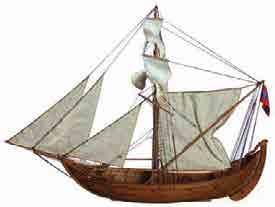
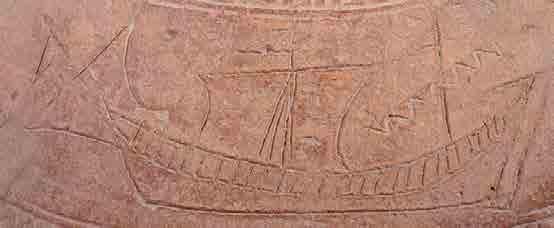
νέβαλε στον έλεγχο του εμπορίου της Ανατολικής Μεσογείου από αυτές και στην απομόνωση των Βυζαντινών εμπόρων. Στην εποχή των Παλαιολόγων (1261-1453) ο ρόλος των βυζαντινών στο μεγάλο διαμετακομιστικό εμπόριο της Ανατολής έχει συρρικνωθεί χωρίς, ωστόσο, να έχει σβήσει. Οι Βυζαντινοί συνέχισαν να εμπορεύονται στο Αιγαίο και στη Μαύρη Θάλασσα, όπου παρουσιάζονται έμποροι από την Κωνσταντινούπολη, την Αδριανούπολη, τη Θεσσαλονίκη, το Μυστρά και τη Μονεμβασία. ΤΑ ΠΛΟΙ Α Οι πληροφορίες για τα εμπορικά πλοία της βυζαντινής περιόδου προέρχονται κυρίως από τα ευρήματα της ενάλιας αρχαιολογίας καθώς και από ένα περιορισμένο αριθμό απεικονίσεων. Το ναυάγιο ενός μικρού εμπορικού πλοίου του 7ου αιώνα κοντά στο νησάκι του Yassi Ada, απέναντι από την Κω, μας δίνει μια ολοκληρωμένη εικόνα των αλλαγών που συντελέστηκαν από την ελληνορωμαϊκή στη βυζαντινή ναυπηγική, καθώς αποτυπώνει τη μετάβαση από την αρχαία τεχνική κατασκευής του κύτους «πρώτα το πέτσωμα» (shell rst) και μετά οι νομείς, στη νεότερη «πρώτα ο σκελετός» των νομέων (skeleton rst) και μετά το πέτσωμα. Στο ναυάγιο του Yassi Ada η κατασκευή του σκάφους μέχρι την ίσαλο γραμμή είχε πραγματοποιηθεί σύμφωνα με την αρχαία τεχνική και από εκεί και πάνω στερεώθηκαν νομείς από φτελιά πάνω στους οποίους καρφώθηκαν οι σανίδες πετσώματος με σιδερένια καρφιά. Η τεχνική αυτή φαίνεται να τελειοποιείται σε ακόμα ένα άλλο ναυάγιο του 11ου αιώνα στην ίδια περιοχή. Τα εμπορικά σκάφη της περιόδου ήταν σχετικά μικρά, με στρογγυλό κύτος, και είχαν έναν έως τρεις ιστούς με τριγωνικά πανιά (λατίνια). Τα πλοία κατευθύνονταν με τη βοήθεια δύο πηδαλίων εκατέρωθεν της πρύμνης, και ήταν κατ’ εξοχήν ιστιοφόρα πλοία, παρόλο που ορισμένοι τύποι χρησιμοποιούσαν και κουπιά. Μετά τον 12ο αιώνα, η εισβολή των ξένων στο εμπόριο γίνεται αισθητή και από τους τύπους των εμπορικών πλοίων που οι Βυζαντινοί άρχισαν να χρησιμοποιούν για τις μεταφορές τους. Τέτοια ξένα είδη εμπορικών πλοίων, που αναφέρονται είναι το λιγνόν, η γριπάρεα, η ταρίδα, ο χιγούτος, και άλλα.
Δεξιά: Καΐκι της Ινέπολης με ιστιοφορία σακολέβα. Ομοίωμα: Κλίμακα 1/30. Κατασκευή: Αριστοτέλης Ράλλης. Έρευνα και σχέδια: F.E.Paris, Κ. Δαμιανίδης. Συλλογή Ν.Μ.Ε. Στην περιοχή της Ινέπολης του Πόντου στις ακτές της Μαύρης Θάλασσας επιβίωσε ως τις αρχές του 20ού αι. η αρχαία τεχνική ναυπήγησης πρώτα το πέτσωμα
Κάτω: Πήλινος πίθος βυζαντινής εποχής για μεταφορά κρασιού (λεπτομέρεια). Φέρει εγχάρακτες παραστάσεις εμπορικού πλοίου και δρόμωνος. Από την Εύβοια. Συλλογή Ν.Μ.Ε.
23
1453-1821.
The Turkish Occupation Period. 1453-1821.
C REAT ION OF T HE H ELLENIC CO MM ERCIAL SHIPPING
After the fall of Constantinople by the Ottomans, there was a period of bloody conflicts between Venetians and Turks over the ruling of the Aegean, while, at the same time, the sea was preyed on by pirates. The change of situation was signaled by the establishment of the ottoman rule over the whole of the Greek area, since the beginning of the 17 th century, and a relative peace prevailed.
As the Ottoman rulers were never good sailors, they virtually gave free scope, in the eld of shipping, to their Greek subjects. From the sporadic information available, it becomes evident that, in the rst half of the 18th century, the internal trade of the Ottoman Empire had come into the hands of the Greek seafarers. This situation caused the suitable conditions for the creation of a blooming Hellenic merchant shipping, far sooner than the establishment of an independent Hellenic state.
The remarkable development of shipping, which occurred in the 2nd half of the same century, is due to the favorable international circumstances that allowed Greek ship-owners to expand their commercial activities to the ports of Europe, Russia, even those of America. This evolution comprised the Napoleonic wars and the frequent con icts between Russia and Turkey, culminating in the Treaty of Kuchuk Kainarji, signed after the rst Russian-Turkish war (1768-1774), which was decisive for Greek seamen. According to the Treaty, Greek ships could use the Russian ag and sail freely through the Bosporus and the Dardanelles Straits. This resulted in the transportation of Russian grain coming into the hands of Greek ship-owners, who made great fortunes out of this business. The Greek gains were even bigger, when they would break through the blockades of European ports, imposed by the British eet, during the Napoleonic wars. Part of the pro ts was invested in building new ships, but the largest part was used to nance the Revolution in 1821.
THE FLEE T OF T HE G REEK RE VOLU T IONARIES IN 1821
On the eve of the Revolution, Greek ship-owners possessed the impressive number of about 1000 merchant ships coming mainly from the islands of Hydra, Spetses and Psara. Most ships were brigs with two
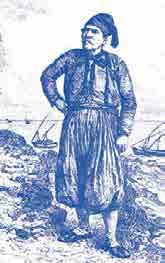

Η ΔΗΜΙΟΥΡΓΙΑ ΤΗΣ ΕΛΛΗΝΙΚΗΣ ΕΜΠΟΡΙΚΗΣ ΝΑΥΤΙΛΙΑΣ Μετά την κατάλυση της Κωνσταντινούπολης από τους Οθωμανούς ακολούθησε μία περίοδος αιματηρών συγκρούσεων ανάμεσα σε Βενετούς και Τούρκους, που πολεμούσαν για την κυριαρχία στο Αιγαίο, ενώ παράλληλα η πειρατεία λυμαινόταν το πέλαγος. Η αλλαγή αυτής της κατάστασης σηματοδοτείται με την εδραίωση της οθωμανικής κυριαρχίας σε όλο τον ελληνικό χώρο από τις αρχές του 17 ου αι. και την επικράτηση σχετικής ειρήνης. Οι Οθωμανοί κατακτητές καθώς δεν ήταν ποτέ καλοί ναυτικοί, άφησαν ουσιαστικά ελεύθερο το πεδίο στον τομέα της ναυτιλίας στους Έλληνες υπηκόους τους. Από σποραδικές μαρτυρίες γίνεται αντιληπτό πως στο πρώτο μισό του 18ου αι. το εσωτερικό εμπόριο της Οθωμανικής Αυτοκρατορίας είχε περιέλθει στα χέρια των Ελλήνων ναυτικών. Αυτή η εξέλιξη δημιούργησε τις κατάλληλες προϋποθέσεις για τη δημιουργία μίας ανθηρής ελληνικής εμπορικής ναυτιλίας, πολύ νωρίτερα από την ύπαρξη ανεξάρτητου ελληνικού κράτους. Η πρωτοφανής ανάπτυξη της ναυτιλίας που συντελέσθηκε στο β΄ μισό του ίδιου αιώνα οφείλεται στην ευνοϊκή διεθνή συγκυρία που επέτρεψε στους Έλληνες πλοιοκτήτες να επεκτείνουν τις εμπορικές τους δραστηριότητες στα λιμάνια της Ευρώπης, Ρωσίας ακόμα και Αμερικής. Τη συγκυρία συνιστούσαν οι ναπολεόντειοι πόλεμοι και οι συχνές ρωσοτουρκικές συγκρούσεις, με επιστέγασμα την καθοριστική για τους Έλληνες ναυτίλους, Συνθήκη του Κιουτσούκ Καϊναρτζή, η οποία υπογράφηκε μετά τον πρώτο Ρωσο-τουρκικό πόλεμο (1768-1774). Σύμφωνα με αυτήν τα ελληνικά πλοία μπορούσαν να χρησιμοποιούν τη ρωσική σημαία και να διαπλέουν ελεύθερα τα Στενά των Δαρδανελίων και του Βοσπόρου. Το αποτέλεσμα ήταν οι μεταφορές των ρωσικών σιτηρών να περάσουν στα χέρια των Ελλήνων πλοιοκτητών, οι οποίοι συγκέντρωσαν μεγάλες περιουσίες από αυτές τις επιχειρήσεις. Το κέρδος των Ελλήνων ήταν ακόμα μεγαλύτερο όταν διασπούσαν τους αποκλεισμούς των ευρωπαϊκών λιμανιών που επέβαλε ο βρετανικός στόλος κατά τη διάρκεια των ναπολεοντείων πολέμων. Ένα μέρος από τα κέρδη τα επένδυαν σε ναυπηγήσεις καινούργιων πλοίων, αλλά το μεγαλύτερο μέρος χρηματοδότησε την Επανάσταση του 1821.
Εποχή Τουρκοκρατίας.
Ψαριανή γαλιότα (18ος-19ος αι.) Ομοίωμα. Συλλογή ΝΜΕ. : Galiot
24
from the island of Psara (18th-19thcentury). Model. H.M.M. collection.
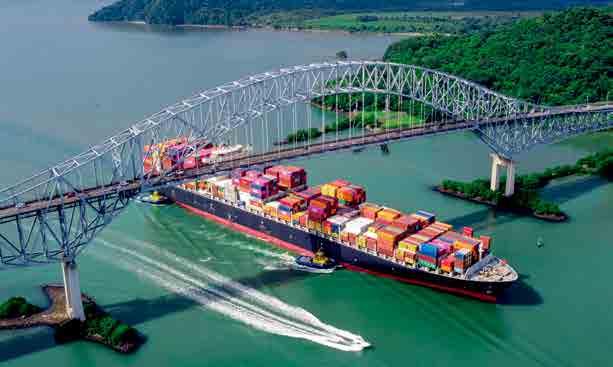
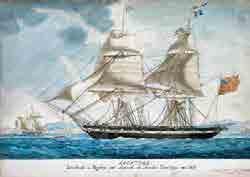
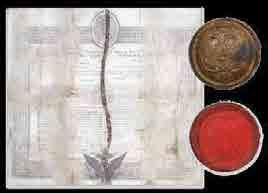
The brig “Leonidas” from Hydra, at the port of Marseille, in 1812. Aquarelle 47×62 cm. H.M.M. collection.
Left:
Right: Sailing permission to the brig “Epamenondas”, according to which she can carry the Russian ag and sail everywhere in the Mediterranean. It is accompanied and rati ed by the Seal of the Russian Empire. It is dated September 22, 1816. H.M.M. collection.
large masts, of a 250 tons displacement and were armed with 8 to 16 canons, in order to confront the pirates still lurking in Mediterranean. After the declaration of the Revolution in Peloponnese, those merchant ships were converted into warships. It was an uneven confrontation. However, where the Greeks excelled, was in the unequalled seamanship of the captains and their crews, who, with skillful maneuvering of their small but agile boats, succeeded in prevailing upon the Turkish warships that lacked in organization and e ectiveness. These maritime skills were transmuted into the regular use of the re-boats that were the great and novel weapon in the sea ghts, during the Greeks’ Revolution. It is beyond any doubt, that, without those ex-merchant vessels the Revolution would not have gone far.



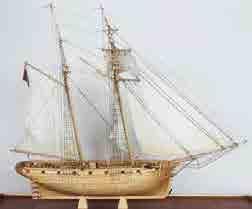
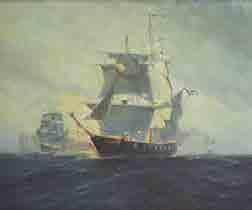
Ο Σ ΤΟΛΟ Σ ΤΩΝ Ε ΛΛΗΝΩΝ Ε ΠΑΝΑ Σ ΤΑΤ Ω Ν ΤΟ Υ 1821 Τις παραμονές της Επαναστάσεως οι Έλληνες πλοιοκτήτες διέθεταν τον εντυπωσιακό αριθμό των 1.000 περίπου εμπορικών πλοίων. Τρία νησιά είχαν τους μεγαλύτερους εμπορικούς στόλους: η Ύδρα, οι Σπέτσες και τα Ψαρά. Τα περισσότερα καράβια ήταν μπρίκια με δύο μεγάλα κατάρτια, με εκτόπισμα 250 τόνων και ήταν εξοπλισμένα με 8 έως 16 κανόνια για να αντιμετωπίζουν τον κίνδυνο των πειρατών που ακόμα τότε ελλόχευε στις θάλασσες της Μεσογείου. Με την κήρυξη της Επαναστάσεως στην Πελοπόννησο, τα ίδια εμπορικά πλοία μετατράπηκαν σε πολεμικά. Η αναμέτρηση ήταν άνιση. Εκεί όμως που υπερείχαν οι Έλληνες ήταν η απαράμιλλη ναυτοσύνη των καπεταναίων και πληρωμάτων, που κατόρθωναν με τον επιδέξιο χειρισμό των μικρών αλλά ευέλικτων πλοίων τους, να επικρατούν των υστερούντων σε οργάνωση και αποτελεσματικότητα τουρκικών πολεμικών πλοίων. Οι ναυτικές αυτές δεξιότητες ανεφάνησαν ιδιαίτερα στην τακτική χρησιμοποίηση των πυρπολικών που αποτέλεσε το μεγάλο και καινοφανές όπλο του ναυτικού αγώνα της Επανάστασης των Ελλήνων. Η προσεκτική μελέτη της ιστορίας του Αγώνα αποδεικνύει, χωρίς καμμία αμφιβολία, ότι χωρίς το Ναυτικό η Επανάσταση δεν θα είχε επεκταθεί πέρα από την Πελοπόννησο, δεν θα είχε στεριώσει και τελικά δεν θα είχε επικρατήσει.
Αριστερά: Αντώνιος Κριεζής, Το υδραίικο μπρίκι “Λεωνίδας” στο λιμάνι της Μασσαλίας το 1812. Υδατογραφία 47x62 εκ. Συλλογή ΝΜΕ.
Δεξιά: Γραπτή άδεια ναυσιπλοΐας στο μπρίκι “Επαμεινώνδας” βάσει της οποίας επιτρέπεται να φέρει τη ρωσική σημαία και να διαπλέει τη Μεσόγειο. Συνοδεύεται και επικυρώνεται από τη ρωσική αυτοκρατορική Βούλα. Φέρει την ημερομηνία, 22 Σεπτεμβρίου
Συλλογή ΝΜΕ.
Αριστερά: Η γολέτα “ Tερψιχόρη” της οικογένειας Τομπάζη. Ομοίωμα. Κατασκευή: Δημήτριος Μπάρδης. Συλλογή ΝΜΕ.
Δεξιά: Νικόλαος Καλογερόπουλος, Το μπρίκι “Άρης”. Λάδι σε καμβά, 54x67 εκ. Συλλογή ΝΜΕ.
Πάνω: Οι επαναστατικές σημαίες της Ύδρας, των Σπετσών και των Ψαρών. Αναπαραστάσεις. Συλλογή ΝΜΕ.
26
Antonios Kriezis,
1816.
Left: Schooner “Terpsichori” belonging to the Tompazis family. Model by Dimitrios Bardis. H.M.M. collection.
Right: Nikolaos Kalogeropoulos, The brig “Aris”. Oil on canvas, 54×67
cm.
H.M.M. collection.
Above: Revolutionary ags of the islands of Hydra, Spetses and Psara. Representations made by Hellenic Maritime Museum. H.M.M. collection.






Authorized agents and distributors in Greece and Cyprus Repair Spare Parts Surveys 24/7 support New Buildings Maintenance Installation info@marilot.gr www.marilot.gr +30.210.45.37.374 We guide you safely in a world of continuous challenges We invest in long-term partnerships with the leading manufacturers of the industry We strive for reliable, energy-e cient, and cost-e ective navigation YEARS KEEPING OUR PROMISE
Contemporary Period. 1830-Today.
E S TABLISHING CO MM ERCIAL NE T WORKS
Since the second half of the 18th century, ship-owners from the Ionian islands mainly, set the foundations for the subsequent great Hellenic commercial shipping. They establish commercial networks at all the main ports of the Black Sea, the Mediterranean and Western Europe. Commercial Firms open o ces in the Sea of Azof, Odessa, Taganrok , Varna, the Danube’s banks, Trapezounda, Constantinople, Syros, Trieste, Livorno, Palermo, Marseille, Antwerp and other ports.
After the creation of the newly established Hellenic state, the trends of the sea trade, during the 19th century, were characterized by the need to transfer cargo in the mass, especially grain, coal and cotton. Big Commercial Firms build eets, by which they primarily serve the need for transfer of goods they trade themselves. Commercial networks provide shipping networks and an endless series of products is transported from one place to another. Eastern Mediterranean is connected with the world market, while the Black Sea functions as the granary of 19th century Europe. Commercial ships carry raw materials and foodstu s to Europe and from there they export industrial goods to the rest of the world.
I N T RODUC T ION OF S T EA M.
F IRS T NAT IONAL SHIPPING CO M PANY
Greek shipping is greatly favored by the explosive rise of commerce and shipping in Eastern Mediterranean.
Steam, which appeared as the future means for the propulsion of ships, even from the beginning of the 19th century, gradually sup-
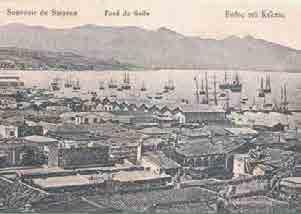
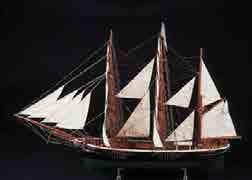

ΔΗΜ Ι Ο ΥΡ ΓΙ Α ΕΜ Π Ο ΡΙΚ Ω Ν ΔΙΚΤ ΥΩΝ Από το δεύτερο μισό του 18ου αιώνα οι πλοιοκτήτες κυρίως των Ιονίων νήσων θέτουν τις βάσεις της μετέπειτα μεγάλης ελληνικής εμπορικής ναυτιλίας. Δημιουργούν μεγάλα εμπορικά δίκτυα που σταθμεύουν σε όλα τα κύρια λιμάνια του Ευξείνου Πόντου, της Μεσογείου και της Δυτικής Ευρώπης. Εμπορικοί Οίκοι εγκαθιστούν γραφεία στην Αζοφική, στην Οδησσό, το Ταϊγάνιο, τη Βάρνα, τα παράλια του Δούναβη, την Τραπεζούντα, την Κωνσταντινούπολη, τη Σύρο, την Τεργέστη, το Λιβόρνο, το Παλέρμο, τη Μασσαλία, το Λονδίνο, την Αμβέρσα και σε άλλα λιμάνια. Μετά τη δημιουργία του νεοσύστατου ελληνικού κράτους η τάση του θαλάσσιου εμπορίου κατά τον 19ο αιώνα χαρακτηριζόταν από την ανάγκη μεταφοράς χύδην φορτίων, κυρίως σιτηρών, κάρβουνου και βάμβακος. Οι μεγάλοι Εμπορικοί Οίκοι δημιουργούν στόλους με τους οποίους εξυπηρετούν κατ’ αρχήν τις ανάγκες μεταφοράς των προϊόντων που εμπορεύονται οι ίδιοι. Τα εμπορικά δίκτυα τροφοδοτούν τα ναυτιλιακά δίκτυα και μία ατελείωτη σειρά προϊόντων μεταφέρεται από τον ένα τόπο στον άλλο. Η Ανατολική Μεσόγειος συνδέεται με την παγκόσμια αγορά ενώ η Μαύρη Θάλασσα λειτουργεί ως σιτοβολώνας της Ευρώπης του 19ού αιώνα. Τα εμπορικά πλοία μεταφέρουν πρώτες ύλες και είδη διατροφής στην Ευρώπη και απ’ αυτήν εξάγουν βιομηχανικά αγαθά προς τον λοιπό κόσμο. Ε Ι Σ Α ΓΩ Γ Η ΤΟ Υ ΑΤ ΜΟΥ. Π Ρ ΩΤ Η Ε ΘΝΙΚΗ ΑΤ ΜΟ ΠΛΟ ΪΚΗ Ε ΤΑΙΡ ΕΙ Α Η εκρηκτική άνοδος του εμπορίου και της ναυτιλίας της Ανατολικής Μεσογείου ευνοεί ιδιαίτερα την ελληνική ναυτιλία. Ο ατμός, που από τις αρχές του 19ου αιώνα εμφανίζεται ως το μελλοντικό μέσο πρόωσης των πλοίων, αρχίζει σταδιακά να εκτοπίζει τα πανιά. Οι Έλληνες πλοιοκτήτες μολονότι κατάλαβαν νωρίς τα πλεονεκτήματα της καινοτομίας βρέθηκαν σε αδυναμία, αρχικά τουλάχιστον, να ανταποκριθούν στην πρόκληση της τεχνολογίας, λόγω αφ’ ενός έλλειψης κεφαλαίων και θεσμών δανειοδότησης, αφ’ ετέρου έλλειψης τεχνικής εμπειρίας και εξειδικευμένου προσωπικού, που απαιτούσαν τα πλοία αυτά. Είναι χαρακτηριστικό ότι τα πρώτα ατμοκίνητα αγοράσθηκαν από Έλληνες της Διασποράς, όπως της Ρουμανίας και της Τεργέστης και ακολούθησαν οι πλοιοκτήτες της ανεξάρτητης Ελλάδας. Με την πάροδο των χρόνων τα εμπορικά πλοία αποκτούν εξειδικευμένα χαρακτηριστικά ανάλογα με το φορτίο που μεταφέρουν. Το 1856 η ελληνική κυβέρνηση αγόρασε τρία ατμοκίνητα επι -
Νεοελληνικό Κράτος - Σύγχρονη Εποχή. 1830-Σήμερα.
Πάνω: Το καραβόσκαρο “Αργώ” με ιστιοφορία μπάρκο, ναυπηγημένο στη Σύρο το 1873. Ομοίωμα σε κλίμακα: 1/58. Κατασκευή: Δημήτριος Ι. Βατής. Συλλογή ΝΜΕ. Above: The boat “Argo” with barque sail rigging built at Syros, in 1873. Scale 1/58. Model by Dimitrios I. Vatis. H.M.M. collection. Δεξιά: Ταχυδρομικό δελτάριο με φωτογραφία του Νεωρίου της Σύρου. Συλλογή ΝΜΕ.
Αριστερά: Ταχυδρομικό δελτάριο με φωτογραφία του λιμανιού της Σμύρνης. Συλλογή ΝΜΕ.
28
Right: Post card showing a picture of Neorio, in Syros. H.M.M. collection.
Left: Post card showing a picture of Smyrna harbor. H.M.M. collection.
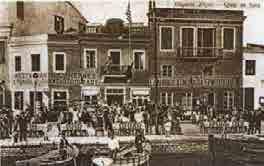
planted the sails. Although Greek ship-owners realized, early on, the advantages of this novelty, they were unable, initially, at least, to respond to this challenge of technology, due to lack of funds and loaning institutions, on one hand, and on the other hand, lack of technical experience and trained personnel, required for these ships.
It is characteristic that the rst steam-powered ships were bought by Greeks living abroad, like those in Rumania and Trieste and the ship-owners of the independent Greece followed.
As the time goes by, commercial ships acquire specialized features, depending on the cargo they carry.
In 1856, the Greek government bought three steam-powered cruise-liners and formed the rst national company, in order to cover the needs of connecting the islands with the ports on the Greek mainland. About the end of the 19th century, the transoceanic shipping began to develop, to serve the growing emigration tide.
PAR T ICIPAT ION IN T HE 20TH CEN T URY WARS
During the wars, in the 20th century, the Balkan wars and World Wars I and II, the Greek merchant marine acted as the fourth service, on the side of the ghting Greek armed forces. It gave its own battle, carrying vital supplies to the people of Europe, through the naval blockades by enemy submarines, surface raiders, mine elds and air raids. World War II, in particular, proved to be extremely devastating to Greek shipping. During the war, it lost 77% of its ships and 70% of its capacity, together with over 2500 human losses, without counting the thousands of injured people, the psychologically disturbed and physically disabled, who survived, after the sinking of the ships.
R EGENER AT ION AND T HE WAY TO T HE TOP
After the war, in acknowledgement of the great contribution made by commercial shipping to the issue of freedom, the USA granted 100 Liberty–type cargo ships and 7 T2-type tankers to Greek shipowners, on favorable nancial terms.
From those ships, the “blessed” ones, as Greek seamen used to call them, began the development, which brought the Greek-owned shipping at the rst place, in world rating.
Today, commercial shipping is the rst source of income for the Greek economy. Besides its obvious nancial signi cance, its presence adds power and prestige to the country, disproportionately great to its size and population, both within the European Union, as well as all over the world.
The components that raised Greek shipping in the rst place of the World are:
Ship-owners that are sensible, hard-working, serious businessmen, who know when to take well calculated business risks.
Crews that are unequalled in seamanship skills and reasoning, well trained in all modern systems that uphold today’s ships. 10000 years of maritime tradition, acquired in the seas that has infused saltiness into the DNA of the Greeks.


βατηγά με τα οποία δημιούργησε την πρώτη εθνική εταιρεία με σκοπό να καλύψει τις ανάγκες σύνδεσης των νησιών με τα λιμάνια της ηπειρωτικής Ελλάδας. Περί τα τέλη του 19 ου αιώνα άρχισε να δημιουργείται και η υπερωκεάνια ναυτιλία για την εξυπηρέτηση του μεταναστευτικού ρεύματος που είχε αρχίσει να ογκώνεται. Σ ΥΜΜΕ ΤΟΧΗ Σ ΤΟ ΥΣ Π ΟΛΕ ΜΟ ΥΣ ΤΟ Υ 20ΟΥ ΑΙ Ω ΝΑ. Στ ους πολέμους του 20 ού αιώνα, Βαλκανικούς, Α΄ και Β΄ Παγκοσμίους, το ελληνικό εμπορικό ναυτικό ενήργησε ως τέταρτο όπλο στο πλευρό των μαχoμένων ελληνικών ενόπλων δυνάμεων. Έδωσε τη δική του μάχη, μεταφέροντας εφόδια ζωής στους λαούς της Ευρώπης, μέσα από τους ναυτικούς αποκλεισμούς των εχθρικών υποβρυχίων, επιδρομικών επιφανείας, ναρκοπεδίων και αεροπορικών επιδρομών. Ιδιαίτερα ο Β΄ Παγκόσμιος Πόλεμος αποδείχθηκε υπερβολικά καταστροφικός για την ελληνική εμπορική ναυτιλία. Κατά τη διάρκειά του απώλεσε το 77% των πλοίων της και το 70% της χωρητικότητάς
περισσότερες
ανθρώπινες απώλειες, χωρίς να υπολογίζονται οι χιλιάδες τραυματίες και οι ψυχικά διαταραγμένοι ή σωματικά ανίκανοι που διασώθηκαν από τα ναυάγια. Η ΑΝΑ Γ ΕΝΝ ΗΣΗ ΚΑΙ Η Π Ο Ρ ΕΙ Α Σ Τ Η Ν ΚΟ ΡΥΦΗ. Ως αναγνώριση της τεράστιας προσφοράς
τιλίας
μετά τον πόλεμο, οι Η.Π.Α. παρεχώρησαν σε Έλληνες εφοπλιστές με ευνοϊκούς οικονομικούς όρους 100 φορτηγά πλοία τύπου Liberty και 7 δεξαμενόπλοια τύπου Τ2. Από τα πλοία αυτά, τα «ευλογημένα», όπως συνήθιζαν να τα αποκαλούν οι Έλληνες ναυτικοί, ξεκίνησε η ανάπτυξη, που έφερε την ελληνόκτητη ναυτιλία στην πρώτη θέση της παγκόσμιας κατάταξης. Σήμερα η εμπορική ναυτιλία είναι η πρώτη συναλλαγματοφόρος πηγή για την ελληνική οικονομία. Η παρουσία της εκτός από την αυτονόητη οικονομική της σημασία προσδίδει δύναμη και κύρος στη χώρα, δυσανάλογα μεγάλο σε σχέση με το μέγεθος και τον πληθυσμό της, τόσο μέσα στο περιβάλλον της Ευρωπαϊκής Ένωσης, όσο και στην υφήλιο ολόκληρη. Τα στοιχεία που την έφεραν και τη διατηρούν στην πρώτη θέση της παγκόσμιας κατάταξης είναι: Εφοπλιστές μυαλωμένοι, νοικοκύρηδες, σοβαροί επιχειρηματίες που γνωρίζουν να αναλαμβάνουν καλώς υπολογισμένο επιχειρηματικό ρίσκο. Πληρώματα απαράμιλλα σε ναυτικές δεξιότητες και αντίληψη, καλά εκπαιδευμένα σε όλα τα σύγχρονα συστήματα που υποστηρίζουν το σημερινό πλοίο. Μια ναυτική παράδοση 100 αιώνων αποκτημένη στις θάλασσες όλου του κόσμου που έχει ενσταλάξει αρμύρα στο DNA της ελληνικής φυλής.
της, μαζί με
από 2.500
της εμπορικής ναυ -
στην υπόθεση της ελευθερίας,
Αριστερά: Η έδρα της Ελληνικής Ατμοπλοΐας στην Ερμούπολη της Σύρου. Ε.Λ.Ι.Α.
E L.I.A. Δεξιά, πάνω: Το φορτηγό ατμόπλοιο “Χαδιώτης” ναυπηγημένο το 1929 για λογαρισμό της εταιρείας Ατμοπλοΐα Κάσου Α.Ε. με έδρα τη Σύρο. Ομοίωμα. Συλλογή ΝΜΕ.
collection. Δεξιά, κάτω:
Left: Hellenic Shipping Company Headquarters, Ermoupoli, Syros.
Right, above: The cargo ship “Hadhiotis”, built in 1929, by order of Kasos Shipping S.A., based in Syros. Model. H.M.M.
29
Right, below:
The "Fourth Service"
The beginning of the 20th century was a period of progress and prosperity for Greek Shipping.

-----
30
Vice Admiral HN (ret.)


Η-----------Aντιναυάρχου Π.Ν. ε.α. 31

Union the war on the side of the Triple Entente
Greek Ship-owners
---
-32


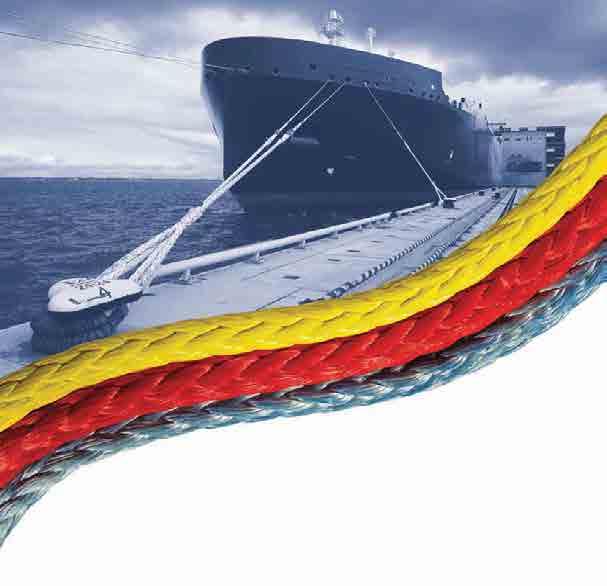
------Year
----.-34
Tons
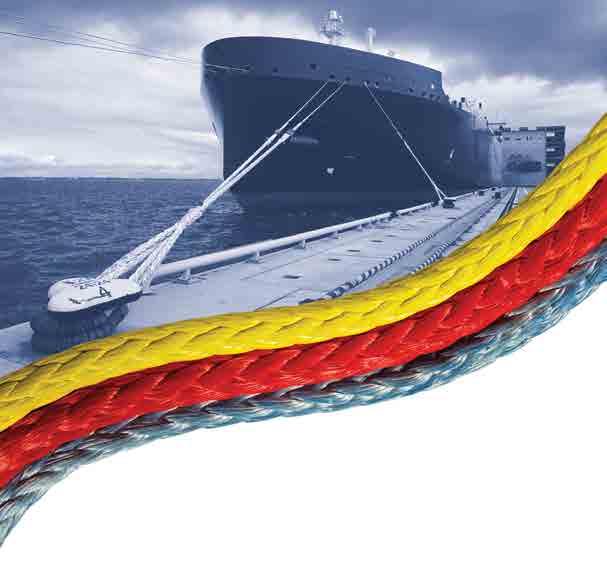



σε όλο τον κόσµο! Με τα υψηλής αντοχής σχοινιά πρόσδεσης, αγκυροβολίας και ρυµουλκήσεως. Ψαρών 11, 18648, Πειραιάς, T: +30 2104060300 - F: +30 2104626268 E: info@katradis.com - www.katradis.com ΟΜΙΛΟΣ ΕΤΑΙΡΕΙΩΝ ΚΑΤΡΑ∆ΗΣ Κάβοι και Σχοινιά Προσδέσεως, Αγκυροβολίας και Ρυµουλκήσεως (Υπερ-υψηλού Μοριακού Βάρους Πολυαιθυλενίου, Αραµιδικά, Πολυµερών Υγρών Κρυστάλλων και Μικτά Πολυεστέρα-Πολυπροπυλενίου), Συρµατόσχοινα, Ανόδια Καθοδικής Προστασίας, Αλυσίδες, Άγκυρες, Εξοπλισµός Λιµένων και Καταστρώµατος Πλοίων σε όλο τον κόσµο! Με τα υψηλής αντοχής σχοινιά πρόσδεσης, αγκυροβολίας και ρυµουλκήσεως. Ψαρών 11, 18648, Πειραιάς, T: +30 2104060300 - F: +30 2104626268 E: info@katradis.com - www.katradis.com ΟΜΙΛΟΣ ΕΤΑΙΡΕΙΩΝ ΚΑΤΡΑ∆ΗΣ Κάβοι και Σχοινιά Προσδέσεως, Αγκυροβολίας και Ρυµουλκήσεως (Υπερ-υψηλού Μοριακού Βάρους Πολυαιθυλενίου, Αραµιδικά, Πολυµερών Υγρών Κρυστάλλων και Μικτά Πολυεστέρα-Πολυπροπυλενίου), Συρµατόσχοινα, Ανόδια Καθοδικής Προστασίας, Αλυσίδες, Άγκυρες, Εξοπλισµός Λιµένων και Καταστρώµατος Πλοίων ∆ένουµε γερά σε όλο τον κόσµο! ΟΜΙΛΟΣ ΕΤΑΙΡΕΙΩΝ ΚΑΤΡΑ∆ΗΣ High Performance Ropes Με τα υψηλής αντοχής σχοινιά πρόσδεσης, αγκυροβολίας και ρυµουλκήσεως. Ψαρών 11, 18648, Πειραιάς, T: +30 2104060300 - F: +30 2104626268 E: info@katradis.com - www.katradis.com ΟΜΙΛΟΣ ΕΤΑΙΡΕΙΩΝ ΚΑΤΡΑ∆ΗΣ Κάβοι και Σχοινιά Προσδέσεως, Αγκυροβολίας και Ρυµουλκήσεως (Υπερ-υψηλού Μοριακού Βάρους Πολυαιθυλενίου, Αραµιδικά, Πολυµερών Υγρών Κρυστάλλων και Μικτά Πολυεστέρα-Πολυπροπυλενίου), Συρµατόσχοινα, Ανόδια Καθοδικής Προστασίας, Αλυσίδες, Άγκυρες, Εξοπλισµός Λιµένων και Καταστρώµατος Πλοίων
Themistocles Patris Syria Atromitos and Adriatikos were: andand contributed to the rescue of hundreds of thousands were Themistocles Naxos Atromitos Adriatikos Pelops Polikos Kaloutas Popi Efstratios Ithaki Andreas Vasilios Chimarra Kyknos Parnassosgrowth.

between the Greek ship-owners and the British Ministry
Greece.
ships.
nd -
st-
-
--
36


-------------Liberty37 -


38---

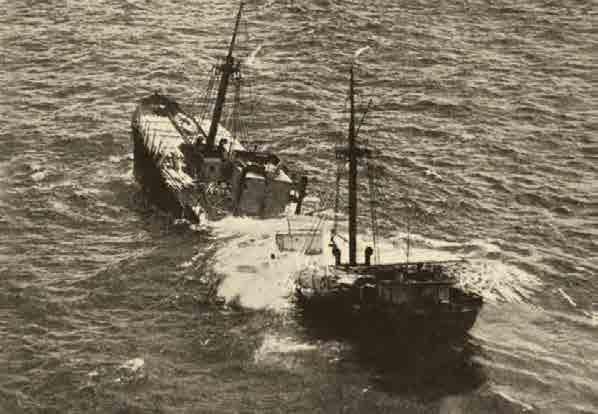
Τ----Aντιναυάρχου Π.Ν. ε.α. 39
construction of ships. Prefabricated sections of the ship
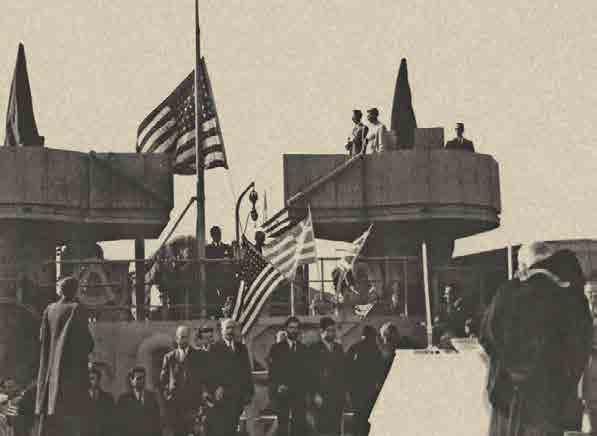
---
Liberties Liberties
TIME-
Hellas Liberty



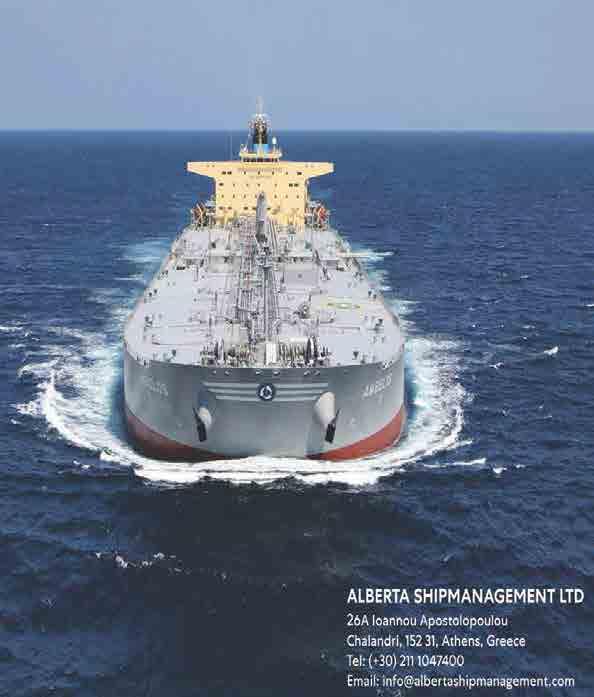
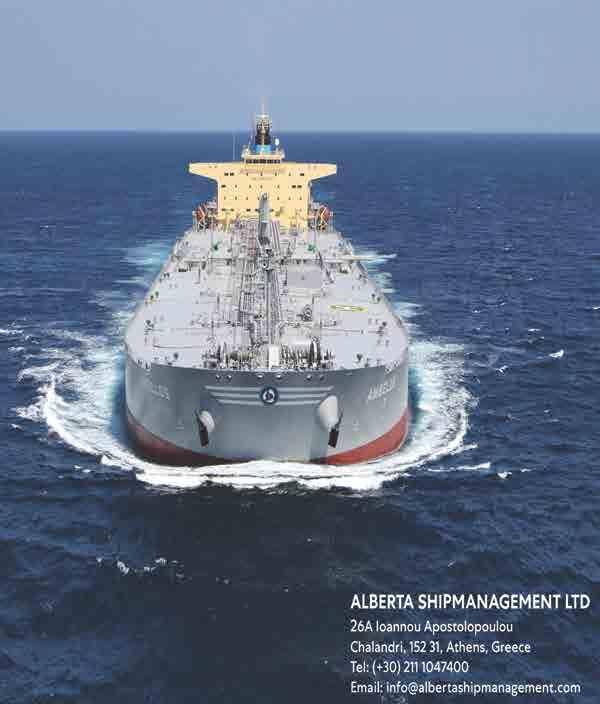
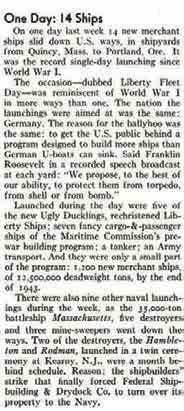
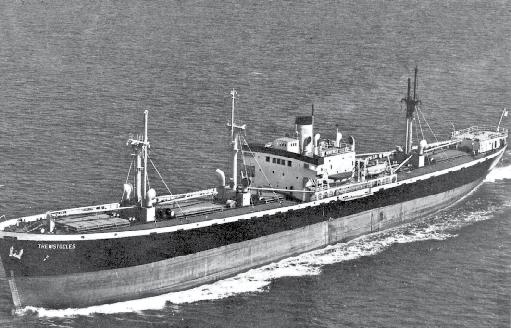
42--LibertiesTo-

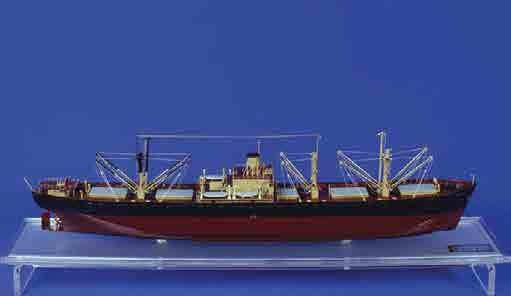
43
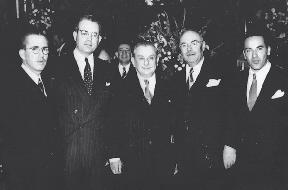


World-Class Shipping, Leading-Edge Expertise
Photo 21-1-2019, 1:00 pm , “M/V MAERSK ENPING”-L.A. World-Class Shipping, Leading-Edge Expertise
DANAOS AND THE ENVIRONMENT ...A LOVE AFFAIR
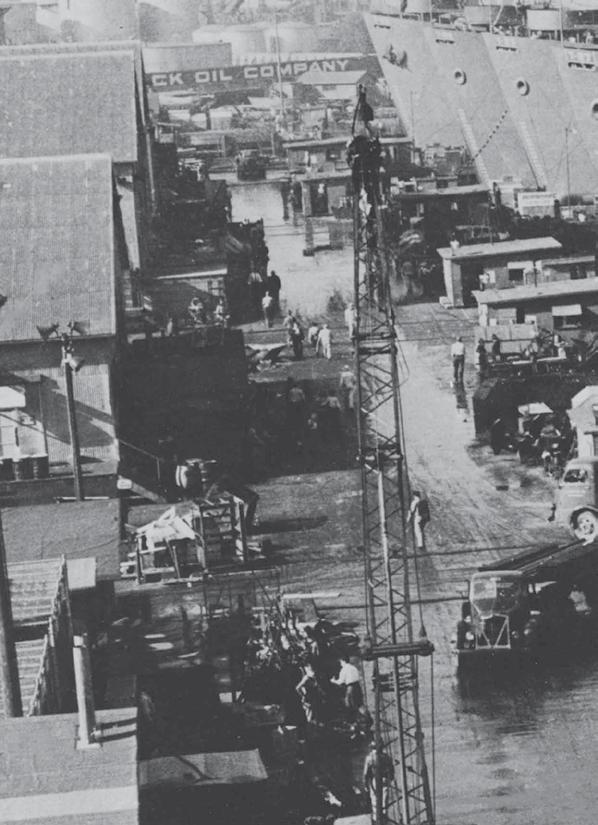

47LibertyLiberties-----
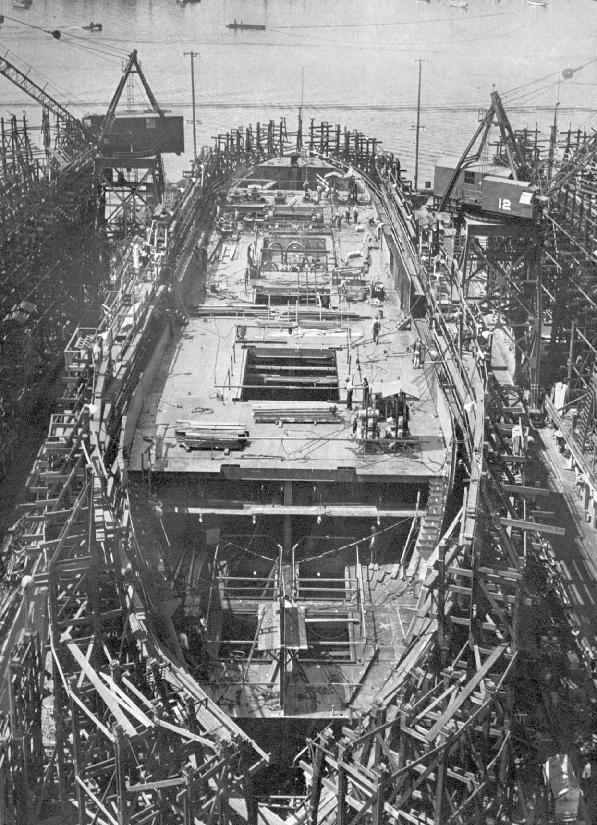
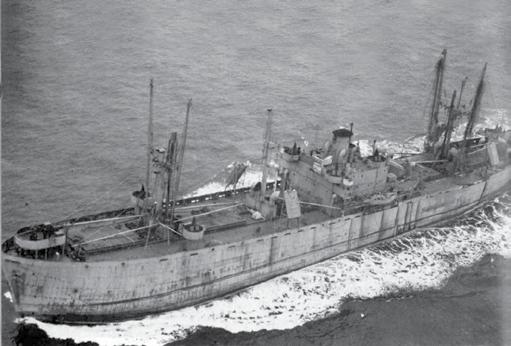
-Liberties-Liberties SS Jeremian SS
. 49
John W.
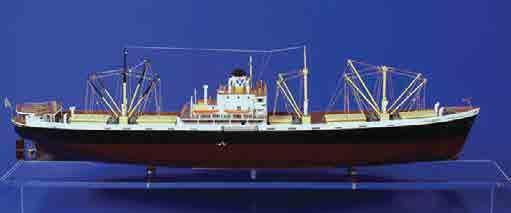

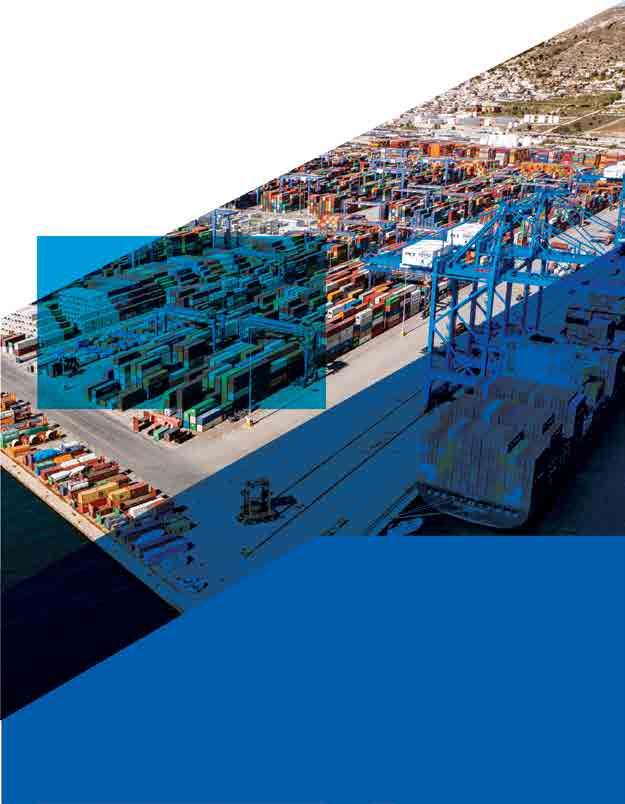
state. the sick and wounded.

tonnage. there by the Turkish authorities.
th
52
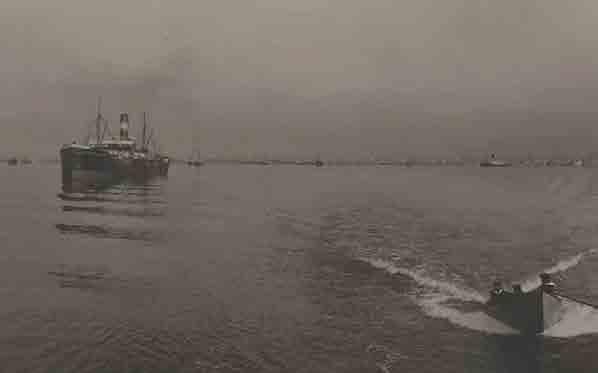
------

be grouped into two categories. progressed.

54

-----.55
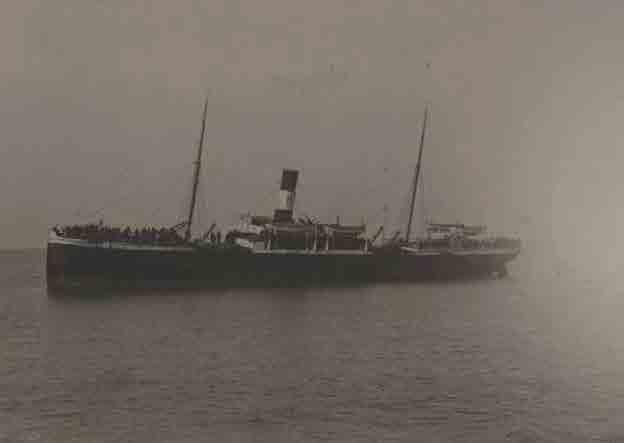
approaches to Piraeus.
3-7 56

------57
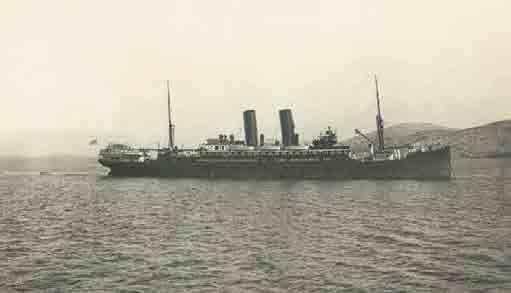
occasions.

58
-
th




-------------59
the t wo p o rt s ha d b ee n c apture d by Mo nt e n e gri n
The troop
carrier.
th troop carrier
The purpose of the transfer was to reinforce the troops deteriorated.



-
--
-
-






-----------------61
1. “A. KORONEOS”
2. “AG. GEORGIOS”
3. “AG. PELAGIA”
4. “ANGGELIKI”
5. “AGNI CHOUNDA”
6. “ATHINAI”
7. “AEOLOS”
8. “ALBANIA”
9. “ALEXANDRA”
10. “ALIKI”
11. “ARGOSTOLION”
12. “ARGO”
13. “ARIS”
14. “ARISTIDIS”
15. “ARKADIA”
16. “ASSOS”
17. “VARVARA”
18. “VOTRYS”
19. “VYZANTION”
20. “D. MICHALINOU”
21. “DELPHIN”
22. “DESPINA”
23. “DIMITRIOS”
24. “DIRPHYS”
25. “ELLADA”
26. “ELENI”
27. “ELPIS”
28 “EMBIRIKOS”
29. “ERIETTA”
30. “ERMOUPOLIS”
31. “ESPERIA”
32. “EPIRUS”
33. “THEMISTOKLIS”
34. “THEOPHANO”
35. “THEOPHANO SIDERIDI”
36. “THESSALIA”
37. “THESSALONIKI”
38. “THRAKI”
39. “I. SIPHNAEOS”
40. “INGLESIS”
41. “ISMINI”
42. “IOANNIS KOUTSIS”
43. “IONIA”
44. “KALOUTAS”
45. “KALYPSO”
46. “KANARIS”
47. “KARYSTINAKIS”
48. “KERKYRA”
49. “KORONAEOS”
50. “KYTHIRA”
51. “KYMA”
52. “KYPROS”
53. “KONSTANTINOS”
54. “LEONARDOS”
55. “LEROS”
56. “LEONIDAS”
57. “M. EMBIRIKOS”
58. “MACEDONIA”
59. “MARGARITA”
60. “MARKETOS”
61. “MONEMVASIA”
62. “MYKALI”
63. “N. VERVENIOTIS”
64. “NAFPLION”
65. “NILOS”
66. “OURANA”
67. “PANOURGIAS”
68. “PATRIS”
69. “PELOPS”
70. “PINIOS”
71. “SAMOS”
72. “SAPPHO”
73. “SESOTRIS”
74. “SIPHNOS”
75. “SOPHIA”
76. “SPARTI”
77. “SPETSAI”
78. “STENIMACHOS”
79. “SFAKTIRIA”
80. “TRIPHYLLIA”
81. “PHROSO”
82.“CHRISTOPHOROS”
83. “CHRYS. SIPHNAEOU”
84. “OREOE”



1. “Α. ΚΟΡΩΝΑΙΟΣ”
2. “ ΆΓ. ΓΕΩΡΓΙΟΣ”
3. “ΑΓ. ΠΕΛ ΑΓΙΑ”
4. “ΑΓΓΕΛΙΚΗ”
5. “ΑΓΝΗ ΧΟΥΝΤΑ”
6. “ΑΘΗΝΑΙ”
7. “ΑΙΟΛΟΣ”
8. “Α ΛΒΑΝΙΑ”
9. “Α ΛΕΞΑΝΔΡΑ”
10. “Α ΛΙΚΗ”
11. “ΑΡΓΟΣΤΟΛΙΟΝ”
12. “ΑΡΓΩ”
13. “ ΆΡΗΣ”
14. “ΑΡΙΣΤΕΙΔΗΣ”
15. “ΑΡΚΑ ΔΙΑ”
16. “ ΆΣΣΟΣ”
17. “ΒΑΡΒΑΡΑ”
18. “ΒΟΤΡΥΣ”
19. “ΒΥΖΑΝΤΙΟΝ”
20. “Δ. ΜΙΧΑ ΛΗΝΟΥ”
21. “ΔΕΛΦΙΝ”
22. “ΔΕΣΠΟΙΝΑ”
23. “ΔΗΜΗΤΡΙΟΣ”
24. “ΔΙΡΦΥΣ”
25. “ΕΛΛ Α ΔΑ”
26. “ΕΛΕΝΗ”
27. “ΕΛΠΙΣ”
29. “ΕΡΙΕΤΤΑ”
30. “ΕΡΜΟΥΠΟΛΙΣ”
31. “ΕΣΠΕΡΙΑ”
32. “ ΉΠΕΙΡΟΣ”
33. “ΘΕΜΙΣΤΟΚΛΗΣ”
34. “ΘΕΟΦΑΝΩ”
35. “ΘΕΟΦΑΝΩ ΣΙΔΕΡΙΔΗ”
36. “ΘΕΣΣΑ ΛΙΑ”
37. “ΘΕΣΣΑ ΛΟΝΙΚΗ”
38. “ΘΡΑΚΗ”
39. “Ι. ΣΙΦΝΑΙΟΣ”
40. “ΙΓΓΛΕΣΗΣ”
41. “ΙΣΜΗΝΗ”
42. “ΙΩΑΝΝΗΣ ΚΟΥΤΣΗΣ”
43. “ΙΩΝΙΑ”
44. “ΚΑ ΛΟΥΤΑΣ”
45. “ΚΑ ΛΥΨΩ”
46. “ΚΑΝΑΡΗΣ”
47. “ΚΑΡΥΣΤΙΝΑΚΗΣ”
48. “ΚΕΡΚΥΡΑ”
49. “ΚΟΡΩΝΑΙΟΣ”
50. “ΚΥΘΗΡΑ”
51. “ΚΥΜΑ”
52. “ΚΥΠΡΟΣ”
53. “ΚΩΝΣΤΑΝΤΙΝΟΣ”
54. “ΛΕΟΝΑΡΔΟΣ”
55. “ΛΕΡΟΣ”
57. “Μ. ΕΜΠΕΙΡΙΚΟΣ”
58. “ΜΑΚΕΔΟΝΙΑ”
59. “ΜΑΡΓΑΡΙΤΑ”
60. “ΜΑΡΚΕΤΟΣ”
61. “ΜΟΝΕΜΒΑΣΙΑ”
62. “ΜΥΚΑ ΛΗ”
63. “Ν. ΒΕΡΒΕΝΙΩΤΗΣ”
64. “ΝΑΥΠΛΙΟΝ”
65. “ΝΕΙΛΟΣ”
66. “ΟΥΡΑΝΑ”
67. “ΠΑΝΟΥΡΓΙΑΣ”
68. “ΠΑΤΡΙΣ”
69. “ΠΕΛΟΨ”
70. “ΠΗΝΕΙΟΣ”
71. “ΣΑΜΟΣ”
72. “ΣΑΠΦΩ”
73. “ΣΕΣΩΣΤΡΙΣ”
74. “ΣΙΦΝΟΣ”
75. “ΣΟΦΙΑ”
76. “ΣΠΑΡΤΗ”
77. “ΣΠΕΤΣΑΙ”
78. “ΣΤΕΝΗΜΑΧΟΣ”
79. “ΣΦΑΚΤΗΡΙΑ”
80. “ΤΡΙΦΥΛ ΛΙΑ”
81. “ΦΡΟΣΩ”
82. “ΧΡΙΣΤΟΦΟΡΟΣ”
83. “ΧΡΥΣ. ΣΙΦΝΑΙΟΥ”
28. “ΕΜΠΕΙΡΙΚΟΣ”
56. “ΛΕΩΝΙΔΑΣ”
84. “ΩΡΕΟΙ”






63

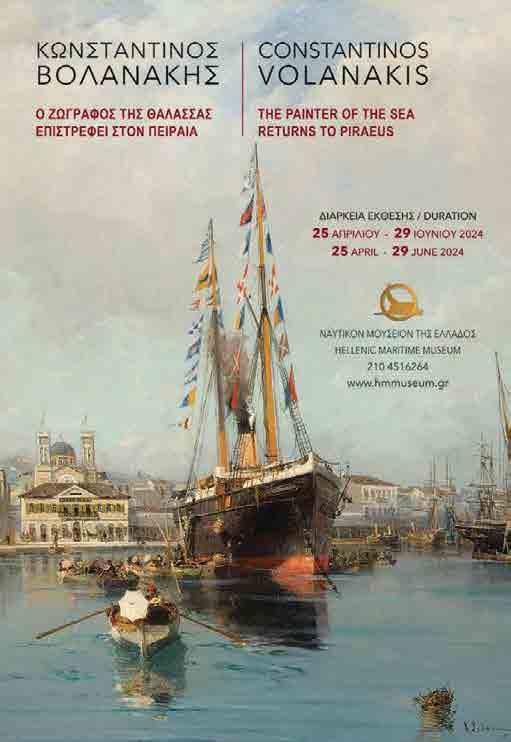
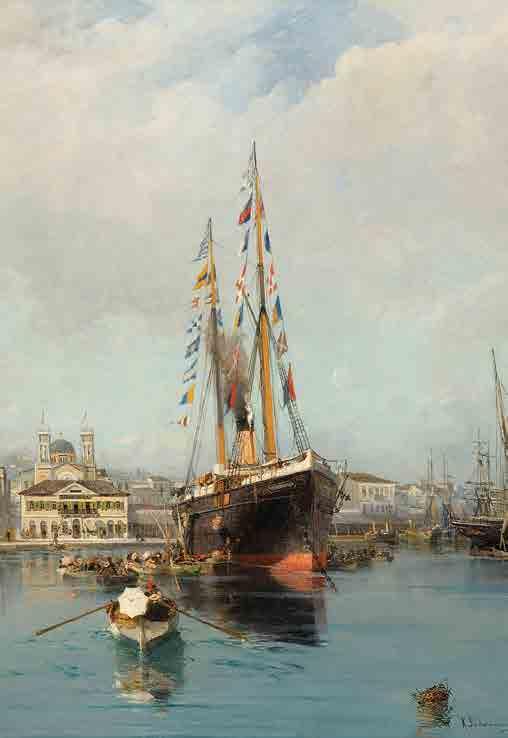
64 ΝΑΥΤΙΚΟ ΜΟΥΣΕΙΟ ΤΗΣ ΕΛΛΑΔΟΣ HELLENIC MARITIME MUSEUM 25 - 29 25 - 29 www.hmmuseum.gr
Constantinos Volanakis
The Hellenic Maritime Museum aims to preserve and showcase our maritime history and tradition. Within the framework of this mission, it designs and implements initiatives that contribute to highlighting our long-standing maritime heritage by revealing the multifaceted relationship of Greeks with the marine element. It’s in this context that it presents the exhibition “Constantinos Volanakis: The painter of the sea returns to Piraeus”. The objective of the exhibition is to present the work of the eminent Greek marine painter to the general public, providing all social groups with unlimited access for the first time. Constantinos Volanakis was among the 19th century’s most prominent Greek artists and was rightfully recognized as the “father of Greek marine painting” long before the end of his career
Throughout the entirety of his artistic path, the sea and the vessel remained his primary subjects.
The exhibition presents fifty-two works from the collection of the Aikaterini Laskaridis Foundation, which is the largest collection of works by the eminent marine painter in our country, three unique historical compositions from the Hellenic Navy Headquarters, The Battle of Salamis, 1882, The Exodus of “Ares”, 1894 and The Arrival of Princess Sophia at Phaleron, 1889-1890 from the collection of Evangelos and Katingo Angelakos, as well as the iconic work The Piraeus Harbor from the Royal Pier, 1886, provided by the Municipality of Piraeus.
Royal
Two magnificent of the artist’s oil paintings from the Hellenic Maritime Museum’s own collection, depicting naval battles of the 1821 Revolution, The Burning of the Turkish Flagship in Eresos and The Battle of Navarino, complement the section of historical narratives.
The exhibition also includes specially designed digital applications that will serve as a complementary tool for visitors to explore and discover the works of this great artist, enriching their experience at the museum.
After fifteen years, Constantinos Volanakis has finally returned — not only to his beloved city of Piraeus, where he lived and worked, but also to a familiar, hospitable haven, the Hellenic Maritime Museum, an institution dedicated to the revival and advancement of Greek seamanship.
Anastasia Anagnostopoulou-Paloubi President of Hellenic Maritime Museum
Κωνσταντίνος Βολανάκης
65
ο Ναυτικό Μουσείο της Ελλάδος έχει ως βασικό σκοπό της λειτουργίας του τη διατήρηση και προβολή της ναυτικής μας ιστορίας και παράδοσης. Στο πλαίσιο αυτής της αποστολής του σχεδιάζει και πραγματοποιεί δράσεις που συντείνουν στην ανάδειξη της μακραίωνης ναυτικής μας κληρονομιάς αποκαλύπτοντας την πολυδιάστατη σχέση του Έλληνα με το θαλασσινό στοιχείο. Στο πλαίσιο αυτό διοργανώνει την έκθεση «Κωνσταντίνος Βολανάκης. Ο ζωγράφος της θάλασσας επιστρέφει στον Πειραιά». Στόχος της έκθεσης είναι να επικοινωνήσει στο ευρύ κοινό το έργο του κορυφαίου Έλληνα θαλασσογράφου, δίνοντας για πρώτη φορά πρόσβαση, χωρίς αποκλεισμούς, σε όλες τις κοινωνικές ομάδες. Ο Κωνσταντίνος Βολανάκης υπήρξε ένας από τους επιφανέστερους Έλληνες καλλιτέχνες του 19ου αιώνα και δικαίως είχε αναγνωριστεί τιμητικά πολύ πριν τελειώσει τη σταδιοδρομία του ως ο «πατέρας της ελληνικής θαλασσογραφίας». Στην έκθεση παρουσιάζονται πενήντα δύο έργα από τη συλλογή του Ιδρύματος Αικατερίνης Λασκαρίδη, που αποτελεί τη μεγαλύτερη συλλογή έργων του κορυφαίου θαλασσογράφου στη χώρα. Επίσης τρεις μοναδικές ιστορικές συνθέσεις από το Αρχηγείο Ναυτικού, Η ναυμαχία της Σαλαμίνας, 1882 και από τη συλλογή Ευάγγελου και Κατίγκως Αγγελάκου, Η Έξοδος του «Άρεως», 1894 και Η άφιξη της πριγκίπισσας Σοφίας στο Φάληρο, 1889- 1890, καθώς και το εμβληματικό έργο Το λιμάνι του Πειραιά από τη βασιλική προβλήτα, 1886, του Δήμου Πειραιά. Δύο μεγαλειώδεις ελαιογραφίες του δημιουργού από τη συλλογή του Ναυτικού Μουσείου Ελλάδος που απεικονίζουν ναυτικά πολεμικά γεγονότα της Επανάστασης του 1821, Η Πυρπόληση του τουρκικού δικρότου στην Ερεσό και η Ναυμαχία του Ναβαρίνου συμπληρώνουν την ενότητα των ιστορικών αφηγημάτων. Στην έκθεση έχουν επίσης, περιληφθεί ειδικά σχεδιασμένες ψηφιακές εφαρμογές οι οποίες θα αποτελέσουν για τον επισκέπτη συμπληρωματικό εργαλείο εξερεύνησης και ανακάλυψης της τέχνης του κορυφαίου δημιουργού, εμπλουτίζοντας τη μουσειακή του εμπειρία. Ο Κωνσταντίνος Βολανάκης ύστερα από δεκαπέντε χρόνια επιστρέφει όχι μόνο στην αγαπημένη του πόλη, τον Πειραιά, όπου έζησε και σταδιοδρόμησε αλλά και σε οικείο, γνώριμο αγκυροβόλι, στο Ναυτικό Μουσείο της Ελλάδος, τόπο αναβίωσης και προβολής της ελληνικής ναυτοσύνης Αναστασία Αναγνωστοπούλου-Παλούμπη Πρόεδρος Ναυτικού Μουσείου Ελλάδος
του επίσης,


Constantinos Volanakis. The painter of the sea returns to Pireaus.
AConstantinos Volanakis was born in Heraklion on March 17, 1837. His father, Demetrios, was a wealthy merchant, and his mother, Harikleia, hailed from Smyrna. In 1851, his father decided to move the family to Syros, a cosmopolitan island with a thriving economy. Constantinos Volanakis was fourteen years old at the time. This decision would play a crucial role in the life of the young student. Around the same time, Hydraean painterportraitist Andreas Kriezis, who had been educated in Paris and was already an established artist, was appointed as a teacher of Drawing at the Gymnasium of Ermoupoli. The meeting of these two eminent artists would be fateful, especially for the future development of Volanakis, whose talent was recognised from the outset by the Hydraean painter, who went on to become his mentor. It should be noted at this point that, based on research into the life and career of Constantinos Volanakis, it appears that he did not complete his gymnasium studies and never obtained a diploma, highlighting the academic behaviour of the great painter, who sought freedom of expression from a young age. The preparation he received from his drawing teacher contributed to his self-confidence, which would be instrumental in the early artistic steps of young Constantinos.
During the same time, Volanakis’ brothers, Athanasios and Ioannis, engaged in trade following in their father’s footsteps, seemingly preparing their younger brother for the same path. After 1856, Constantinos worked as an accountant in the commercial business of his relatives in Trieste, the brothers Theodoros and Georgios Afentoulis. However, his real inclination, even subconsciously, started to emerge when the young Constantinos began to admire the ships in the ports. He went on to study all types of sailing ships, as well as the small boats anchored in the bustling port during the second half of the 19th century, meticulously and with unquenchable interest. From that point on, the vessels would become the quintessential subjects of Volanakis’ art. As Manolis Vlachos excellently observes, his early works were created in a state of absolute freedom from outside pressures, a state of mind that agreed perfectly with his temperament.
It would be wise to mention that Afentoulis was perhaps his most substantial benefactor, as he was the one who encouraged the young Constantinos to follow his true inclination, namely painting, and not business ventures. He thus urged him to study in Munich, the flourishing Bavarian metropolis of the time and a centre of fine arts, neoclassicism, and philhellenism. Volanakis enrolled at the Academy of Munich in 1864, following his successful work at a competition. He was 27 years old, and he entered the Academy at the same time as Theodoros Vryzakis and Nikiforos Lytras. He would not interact with these remarkable artists, but he would develop a special relationship with Nikolaos Gyzis, who arrived in Munich in 1865.
Constantinos Volanakis would engage with landscape painting early on, while completely rejecting folklore painting, the most common and commercially successful genre of the time. Landscape painting was an “uncommercial” subject that was not taught at the Academy, and this fact attracted Volanakis and his free spirit even more. He chose to use
Κωνσταντίνος Βολανάκης.
67
Ο Κωνσταντίνος Βολανάκης γεννήθηκε στις 17 Μαρτίου 1837 στο Ηράκλειο. Ο πατέρας του, Δημήτριος, είναι εύπορος έμπορος και η μητέρα του, Χαρίκλεια, κατάγεται από τη Σμύρνη. Το 1851 ο πατέρας του αποφασίζει να μεταφερθεί η οικογένεια στη Σύρο, ένα κοσμοπολίτικο νησί με ανθηρή οικονομία. O Κωνσταντίνος Βολανάκης είναι τότε δεκατεσσάρων ετών. Η απόφαση αυτή θα έπαιζε καθοριστικό ρόλο στη ζωή του νεαρού μαθητή. Την ίδια ακριβώς περίοδο ήταν διορισμένος στο Γυμνάσιο της Ερμούπολης δάσκαλος της Ιχνογραφίας ο Υδραίος ζωγράφος-προσωπογράφος Ανδρέας Κριεζής, σπουδασμένος στο Παρίσι και ήδη αναγνωρισμένος και καταξιωμένος καλλιτέχνης. Η συνάντηση των δύο κορυφαίων εικαστικών θα ήταν μοιραία, ειδικά για τη μελλοντική εξέλιξη του Βολανάκη, του οποίου το ταλέντο αναγνωρίστηκε ευθύς εξαρχής από τον Υδραίο ζωγράφο και δάσκαλό του. Να αναφέρουμε στο σημείο αυτό ότι με βάση έρευνα για τη ζωή και την πορεία του Κωνσταντίνου Βολανάκη φαίνεται πως ο ίδιος δεν τελείωσε τις γυμνασιακές του σπουδές και ότι δεν πήρε ποτέ απολυτήριο, τονίζοντας την ακαδημαϊκή συμπεριφορά του μεγάλου ζωγράφου, ο οποίος αναζητούσε την ελευθερία της έκφρασης από νεαρή ακόμη ηλικία. Η προετοιμασία που είχε λάβει από τον δάσκαλο ιχνογραφίας τους συνέβαλε στην απόκτηση αυτοπεποίθησης, σημαντικό στοιχείο για τα πρώτα καλλιτεχνικά βήματα του νεαρού Κωνσταντίνου. Την ίδια περίοδο, τα αδέρφια του, Αθανάσιος και Ιωάννης, ασχολούνται με το εμπόριο ακολουθώντας την πορεία του πατέρα τους, ενώ τον ίδιο δρόμο φαίνεται να προετοιμάζουν και για τον μικρότερο αδελφό τους Κωνσταντίνο. Εκείνος, μετά το 1856, εργάζεται ως λογιστής στην επιχείρηση των εμπόρων συγγενών του στην Τεργέστη, στους αδελφούς Θεόδωρο και Γεώργιο Αφεντούλη. Η πραγματική του όμως κλίση, έστω υποσυνείδητα, κάνει την εμφάνισή της, όταν ο νεαρός Κωνσταντίνος παρατηρεί με θαυμασμό τα πλοία στα λιμάνια. Ξεκινά να μελετά λεπτομερώς και με ακόρεστο ενδιαφέρον όλους τους τύπους των ιστιοφόρων και των καϊκιών που λικνίζονταν αγκυροβολημένα στο πολύβουο λιμάνι του β’ μισού του 19ου αιώνα. Έκτοτε το σκάφος θα γίνει για τον Βολανάκη το κατεξοχήν θέμα της τέχνης του. Τα πρώτα του αυτά έργα, όπως εξαιρετικά εύστοχα παρατηρεί ο Μανόλης Βλάχος, δημιουργούνταν υπό συνθήκες ελευθερίας και μακριά από καταναγκασμό, κάτι που ερχόταν σε φυσική αρμονία με την ιδιοσυγκρασία του. Είναι συνετό να αναφερθεί ότι ο Αφεντούλης υπήρξε ίσως ο πιο ουσιαστικός του ευεργέτης, διότι ήταν εκείνος που παρακίνησε τον νεαρό τότε Κωσταντίνο να ακολουθήσει την πραγματική του κλίση δηλαδή τη ζωγραφική και όχι τις επιχειρήσεις. Τον παρακίνησε λοιπόν να σπουδάσει στο Μοναχό, την ακμάζουσα βαυαρική μητρόπολη της εποχής και κέντρο των καλών τεχνών, του νεοκλασικισμού και του φιλελληνισμού. Ο Βολανάκης πραγματοποιεί την εγγραφή του στην Ακαδημία του Μονάχου το 1864, ύστερα από διαγωνισμό. Ήταν τότε 27 ετών και την ιδία εποχή έκαναν την δική τους εισαγωγή στην Ακαδημία ο Θεόδωρος Βρυζάκης και ο Νικηφόρος Λύτρας. Με τους εξαίρετους αυτούς καλλιτέχνες δεν θα σχετιστεί αλλά θα αναπτύξει μια ιδιαίτερη σχέση με τον Νικόλαο Γύζη που φτάνει στο Μόναχο το 1865. Ο Κωσταντίνος Βολανάκης θα καταπιαστεί νωρίς με την τοπιογραφία, ενώ θα απορρίψει εντελώς την ηθογραφία, το περισσότερο διαδεδομένο και εμπορικά επιτυχημένο είδος της εποχής. Η τοπιογραφία ήταν μια «αντιεμπορική» θεματολογία που δεν διδασκόταν στην Ακαδημία και το γεγονός αυτό έλκυε ακόμα περισσότερο την ελεύθερη φύση του Βολανάκη. Από την τοπιο-
landscape painting in order to capture his own childhood experiences, showcasing from very early on the sea and the boat which would go on to make regular appearances in his oil paintings. In 1866, his work was entered into a competition held by Emperor Franz Joseph II for the best depiction of the glorious Austrian naval battles of Lissa. This was his first historical piece, and it won the competition. The award earned him a trip to the Dalmatian coast to familiarise himself with the topography of the battle area and to create an oil painting for the historic moment of the Austrian victory over the Italian fleet. This trip gave him the great opportunity to study the sea in depth, to come into contact with all types of vessels, and to experience the unique beauty of the Adriatic beaches. One success would follow another, and in the following year (1877) he painted The Battle of Trafalgar. This iconic work was acquired by the British Admiralty, honouring the Greek painter who depicted the success of the British navy under Horatio Nelson during the Napoleonic Wars in 1805 in such a magnificent way.
These years in Europe left an indelible mark on Volanakis. In 1869, he came into contact with the work of Gustave Courbet, the quintessential representative of realism in France, for the first time, during the First International Art Exhibition in Munich. This marked the beginning of his shift towards a fresh aesthetic perspective, emphasising realism, embracing vibrant new inspirations in colour and light and elevating the landscape to a prominent position. Volanakis, proficient in landscape artistry, found his primary artistic fascination lay withiseascapes. His work reflects a gradual adaptation to the impressionist movements of the time. Furthermore, his paintings demonstrate a study of earlier Dutch models from the 17th century, which he had the opportunity to research at the most important “school” of Western European painting, the Alte Pinakothek in Munich. There, he would meet not only the great Rembrandt and Willem van de Velde the Younger but also the French artists Claude Lorrain and Claude-Joseph Vernet, as well as the Italians Antonio Canal, better known as Canaletto, and Francesco Guardi. During his time in Munich, Volanakis took part in major exhibitions with seascapes of all kinds. He had established himself as the “painter of the sea”, a rare speciality in the Bavarian kingdom secluded from the Alps. He travelled to many European art capitals such as Vienna, Paris, London, and Venice, where he came into contact with new trends. Volanakis’ studies and long stay in Munich contributed to the creation of works that received widespread acclaim, thus laying the groundwork for a successful time in his career and a joyful period overall. During his time in Munich, he also started a family as, about ten years after his arrival in the Bavarian capital, he married the niece of Georgios Afentoulis, Fani Ioannou Christidou from Zagora. Their wedding took place in Athens, but the couple resided in Munich where their children, Polyxeni and Georgios, were born. Polyxeni was baptized by Gyzis. Volanakis’ trajectory might have seemed harmoniously aligned with Europe, but life made painfully different plans for our great painter. In 1883, he decided to return to Greece due to the fact that the climate of Munich had taken a toll on his wife’s health, thus making perhaps the most tragic mistake of his life, as warned by his friend Gyzis. Upon his return to Greece, in the autumn of 1883, he took over the chair of “Elementary Design” and “Sculpture” at the School of Arts of the Polytechnic School until 1903 (he resigned for health reasons). In fact, in 1900, a magnificent meeting took place between Professor Volanakis and Giorgio De Chirico, then a twelve-year-old student. “When I asked him how oil painting is done, the painter Volanakis answered that it is done with oil... linseed oil.
68
γραφία επιλέγει να αποτυπώσει τα δικά του παιδικά βιώματα, τη θάλασσα και το σκάφος που εμφανίζονται από πολύ νωρίς στις ελαιογραφίες του. Το 1866 συμμετέχει με σχέδιο του και κερδίζει στον διαγωνισμό που είχε προκηρύξει ο αυτοκράτορας Φραγκίσκος Ιωσήφ Β’ για την απεικόνιση της ένδοξης για τους αυστριακούς ναυμαχίας της Λίσσας. Πρόκειται για το πρώτο του ιστορικό έργο. Η βράβευση του αυτή του απέφερε ένα ταξίδι στις δαλματικές ακτές ώστε να γνωρίσει την τοπογραφία της περιοχής της ναυμαχίας και να δημιουργήσει μια ελαιογραφία για την ιστορική αυτή στιγμή των αυστριακών όπου ο στόλος τους κατατρόπωσε τον ιταλικό. Από αυτό του το ταξίδι είχε τη μεγάλη ευκαιρία να μελετήσει σε βάθος τη θάλασσα, να έρθει σε επαφή με κάθε είδος πλεούμενου καθώς και να γνωρίσει την μοναδική ομορφιά των παραλιών της Αδριατικής. Η μια επιτυχία διαδέχεται την άλλη και την επόμε-νη χρονιά (1877) φιλοτεχνεί τη Ναυμαχία του Τραφάλγκαρ. Το εμβληματικό αυτό έργο αποκτήθηκε από το Υπουργείο Ναυτικών της Αγγλίας τιμώντας τον Έλληνα ζωγράφο ο οποίος απεικόνισε με μεγαλειώδη τρόπο την επιτυχία του βρετανικού ναυτικού με αρχηγό τον Οράτιο Νέλσωνα, κατά τη διάρκεια των Ναπολεό-ντειων πολέμων το 1805. Οι χρονιές αυτές αφήνουν βαθύ ευρωπαϊκό στίγμα στον Βολα-νάκη. Το 1869 έρχεται για πρώτη φορά σε επαφή με το έργο του Γκουστάβ Κουρμπέ, του κατεξοχήν εκπροσώπου του ρεαλισμού στη Γαλλία, κατά τη διάρκεια της Πρώτης Διεθνούς Καλλιτεχνικής Έκθεσης στο Μόναχο. Τότε αρχίζει και η μετάβαση σε μια νέα αισθητική προσέγγιση, με το βλέμμα του στραμμένο στον ρεαλισμό και τα έργα του να δέχονται επιδράσεις τόσο ως προς το χρώμα και το φως αλλά και με το τοπίο να αποκτά πρωταγωνιστικό ρόλο. Για τον Βολανάκη, ως ικανότατο τοπιογράφο, η θαλασσογραφία συνιστά τον πυρήνα του καλλιτεχνικού του ενδιαφέροντος. Μέσα από το έργο του διαφαίνεται μια προσαρ-μογή του και στα ιμπρεσιονιστικά ρεύματα της εποχής. Επίσης από τους πίνακες του απορρέει μια μελέτη παλαιότερων ολλαν-δικών προτύπων του 17ου αιώνα που είχε την ευκαιρία να μελε-τήσει στο σημαντικότερο «σχολείο» δυτικοευρωπαϊκής ζωγραφι-κής, στην Παλαιά Πινακοθήκη του Μονάχου. Εκεί θα γνωρίσει όχι μόνο τον μεγάλο Ρέμπραντ και τον Βίλεμ βαν ντε Βέλντε τον Νεότερο αλλά και τους Γάλλους Κλοντ Λορέν και Κλοντ Ζοζέφ Βερνέ καθώς και τους Ιταλούς Αντόνιο Κανάλ (Canaletto) και Φραντσέσκο Γκουάρντι. Βολανάκης συμμε-τέχει αποκλειστικά με θαλασσογραφίες όλων των κλάδων σε μεγάλες εκθέσεις. Είχε εδραιωθεί ως o «ζωγράφος της θάλασσας», μια σπάνια αποκλειστικότητα στο περίκλειστο από τις Άλπεις βασίλειο της Βαυαρίας. Ταξιδεύει σε πολλές ευρωπαϊκές μητρο-πόλεις της τέχνης όπως στη Βιέννη, στο Παρίσι, στο Λονδίνο και στη Βενετία, όπου και έρχεται σε επαφή με τα νέα ρεύματα. Οι σπουδές και η χρόνια παραμονή του Βολανάκη στο Μόνα-χο συνέβαλαν στη δημιουργία έργων που έχαιραν διθυραμβικών κριτικών, δημιουργώντας έτσι μια ευνοϊκή για την επαγγελματική του πορεία ατμόσφαιρα, η οποία κατά τις πηγές ήταν επίσης μια γενικά ευτυχισμένη περίοδος. Κατά τη διάρκεια της επο-χής του Μονάχου ξεκινά και τη δημιουργία της οικογένειάς του καθώς δέκα περίπου χρόνια μετά την άφιξή του στη βαυαρική πρωτεύουσα, παντρεύτηκε τη Φανή Ιωάννου Χρηστίδου από τη Ζαγορά, κόρη της αδελφής του Γεωργίου Αφεντούλη. Ο γάμος έγινε στην Αθήνα αλλά το ζεύγος διαμένει στο Μόναχο όπου γεννιούνται η Πολυξένη και ο Γεώργιος. Την Πολυξένη βάπτισε ο Γύζης. Η πορεία του Βολανάκη μπορεί να έμοιαζε αρμονικά ταυτισμένη με την Ευρώπη, η ζωή όμως έκανε επώδυνα σχέδια επαναπα-τρισμού για τον μεγάλο μας ζωγράφο. Το 1883 λαμβάνει την απόφαση επιστροφής στην Ελλάδα λόγω του γεγονότος ότι το κλίμα του Μονάχου είχε καταβάλει την υγεία της συζύγου του, διαπράττοντας έτσι το τραγικότερο ίσως λάθος της ζωής του, όπως τον είχε προειδοποιήσει ο φίλος του Γύζης. Κατά την επιστροφή στην Ελλάδα, το φθινόπωρο του 1883 ανα-λαμβάνει την έδρα της «Στοιχειώδους Γραφικής» και «Αγαλμα-τογραφίας» στο Σχολείο των Τεχνών του Πολυτεχνείου έως το 1903 (παραιτήθηκε για λόγους υγείας). Μάλιστα, το 1900 λαμ-
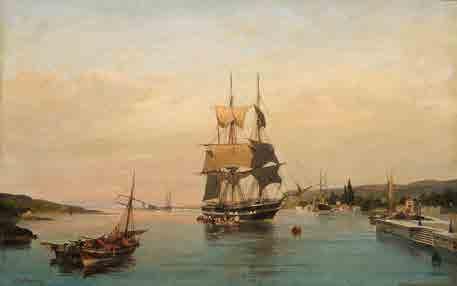
It was a revelation for me”, De Chirico himself would say in 1987.
Volanakis also taught at the Art Centre, which was a school of painting that he founded in Piraeus in 1895. Painting as a personal endeavour was relegated to a much lower priority for the rest of the great marine painter’s life. His reputation as a teacher grew over time. His school became a hotbed of talented painters from Piraeus and Athens. Meanwhile, his family expanded: Angelos, Mary (wife of Antonios Panagiotakis), and Miltiadis, an Athens lawyer and biographer of his father, were born in Piraeus.Upon his return to Greece, Volanakis returned to the subject matter that he had perfected in Munich. During this time, he received few state commissions, while he strug gled to sell various works to framing shops and participate in collective exhibitions. He sporadically dealt with subjects from contemporary life, always related to the sea, such as The Arrival of Princess Sophia at Phaleron. He also continued to depict “heroic” themes and naval battles from Greek history, such as the Battle of Salamis, the Exodus of “Ares” and the Burning of the Turkish Flagship.
A period of decline followed for the great marine painter, who had been honoured by the Emperor of Austria, received commissions from the Viennese and English aristocracy, and was now working as a low-level employee at a framing shop in Piraeus, where he also sold his works. Not even the multitude of his maritime works proved sufficient to sustain the “father of Greek maritime painting”. In 1903, nearing the end of his life, he resigned from the laborious teaching at the Polytechnic. After his death in 1907, he was regarded for many years as an artist who had failed to leave a mark in history. Today, the exact opposite is the case, and his glorious work is celebrated in multiple ways.
Throughout his artistic journey, Volanakis returned to his favorite themes: Ports, Seascapes, Ships, and Historical Events. The works of this exhibition are presented in that order. Af ter all, everything started at the ports of Heraklion, Syros, and Trieste, continuing with his personal interest in seascapes and ships, and reaching an apex during the decisive years of his studies in Munich with an award for his first historical work, which marked the beginning of many similar compositions.
Maria Migadi
Art Historian & Independent Art Consultant Exhibition Curator
Posidonia 3-7 June 2024 69
βάνει χώρα μια μεγαλειώδης συνάντηση μεταξύ του νεαρού δωδεκάχρονου σπουδαστή Ντε Κίρικο και του καθηγητή Βολανάκη. «Ο ζωγράφος Βολανάκης όταν τον ρώτησα πώς γίνεται η ελαιογραφία, μου απάντησε ότι γίνεται με λάδι... με λινέλαιο. Ήταν για μένα μια αποκάλυψη» θα πει ο ίδιος ο Τζόρτζιο ντε Κίρικο το 1987. Ο Βολανάκης δίδασκε και στο Καλλιτεχνικό Κέντρο, το οποίο ήταν μια σχολή ζωγραφικής που ίδρυσε ο ίδιος το 1895 στον Πειραιά. Η ζωγραφική ως προσωπική εργασία υποβιβάζεται σε πολύ χαμηλότερη προτεραιότητα για τη ζωή του μεγάλου θαλασσογράφου. Ηφήμη του ως δασκάλου γίνεται χρόνο με τον χρόνο μεγαλύτερη. Η σχολή του γίνεται φυτώριο ικανών Πειραιωτών και Αθηναίων ζωγράφων. Στο μεταξύ και τα μέλη της οικογένειάς του αυξάνονται: στον Πειραιά γεννιούνται o Άγγελος, η Μαίρη (σύζυγος Αντωνίου Παναγιωτάκη) και ο Μιλτιάδης, δικηγόρος Αθηνών και βιογράφος του πατέρα του. Με την επιστροφή του στην Ελλάδα ο Βολανάκης επαναλαμβάνει τα θέματα που είχε τελειοποιήσει στο Μόναχο. Το διάστημα αυτό δέχεται ελάχιστες κρατικές παραγγελίες ενώ παράλληλα προσπαθεί να πουλήσει διάφορα έργα του σε κορνιζοποιεία ενώ με δυσκολία συμμετέχει σε ομαδικές εκθέσεις. Πραγματεύεται σποραδικά θέματα από τη σύγχρονη ζωή, σε σχέση πάντα με τη θάλασσα, όπως Η άφιξη της πριγκίπισσας Σοφίας στο Φάληρο. Επίσης, εξακολουθεί να πραγματεύεται «ηρωικά» θέματα και ναυμαχίες από την ελληνική ιστορία, όπως Η Ναυμαχία της Σαλαμίνας, Η Έξοδος του « Άρεως», Η Πυρπόληση της τούρκικης ναυαρχίδας. Ακολουθεί μια περίοδος πτώσης για τον σπουδαίο θαλασσογράφο που δοξάστηκε από τον αυτοκράτορα της Αυστρίας, που δέχτηκε παραγγελίες από τη βιεννέζικη και την αγγλική αριστοκρατία, και τώρα είναι υπάλληλος με μεροκάματο στο κορνιζοποιείο του Πειραιά, όπου πουλάει και τα έργα του. Ούτε καν το πλήθος των θαλασσινών έργων του δεν στάθηκαν ικανά να «θρέψουν» τον «πατέρα της ελληνικής θαλασσογραφίας». Το 1903 παραιτείται από την κοπιαστική διδασκαλία στο Πολυτεχνείο και οδεύει προς το τέλος της ζωής του. Μετά τον θάνατό του το 1907 για αρκετά χρόνια η μνήμη του είχε συνδεθεί με εκείνη ενός καλλιτέχνη που δεν άφησε ιστορία. Σήμερα συμβαίνει ακριβώς το αντίθετο και το ένδοξο έργο του αναβιώνει με πολλαπλούς τρόπους. Ο Βολανάκης μεταπλάθει καθ΄ όλη τη διάρκεια της καλλιτεχνικής του διαδρομής τα αγαπημένα του θέματα: Τα Λιμάνια, τα Θαλασσινά Τοπία, τα Πλοία και τα Ιστορικά γεγονότα και με αυτή τη σειρά παρουσιάζονται τα έργα αυτής της έκθεσης. Άλλωστε, η αρχή έγινε σε λιμάνια (Ηράκλειο, Σύρος και Τεργέστη), η συνέχεια καθιέρωσε τα θαλασσινά τοπία και τα πλοία ως επιλογές ψυχής και τέλος, στα καθοριστικά χρόνια των σπουδών στο Μόναχο, ήρθε η βράβευση για το πρώτο ιστορικό έργο, το οποίο ήταν η αρχή πολλών αντίστοιχων δημιουργιών συνθέσεων. Μαρία Μιγάδη Ιστορικός Τέχνης & Ανεξάρτητη Εικαστική Σύμβουλος Επιμελήτρια της έκθεσης
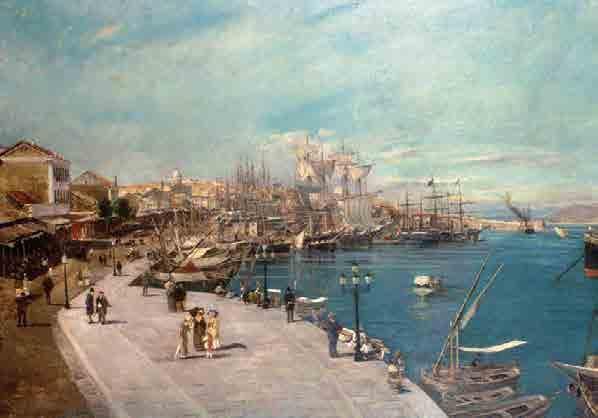

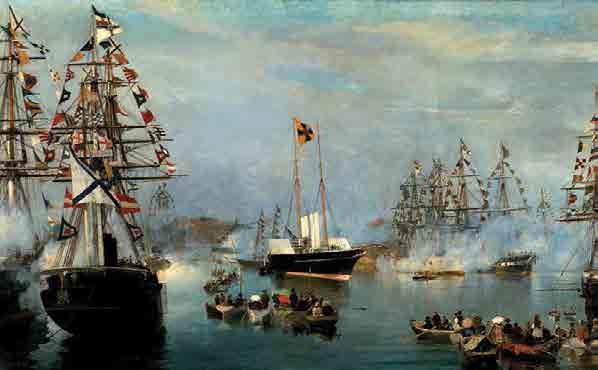
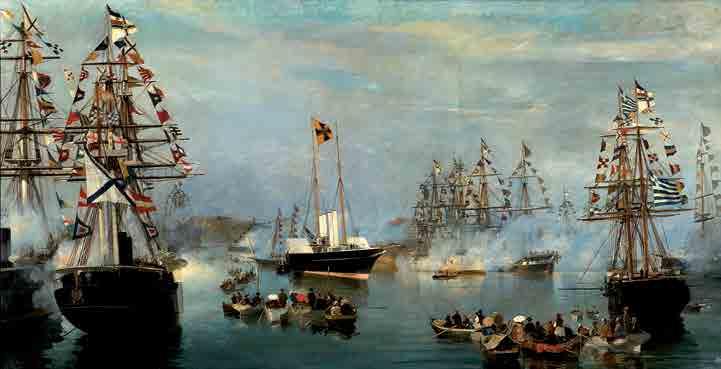





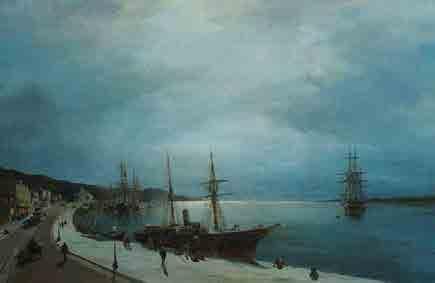





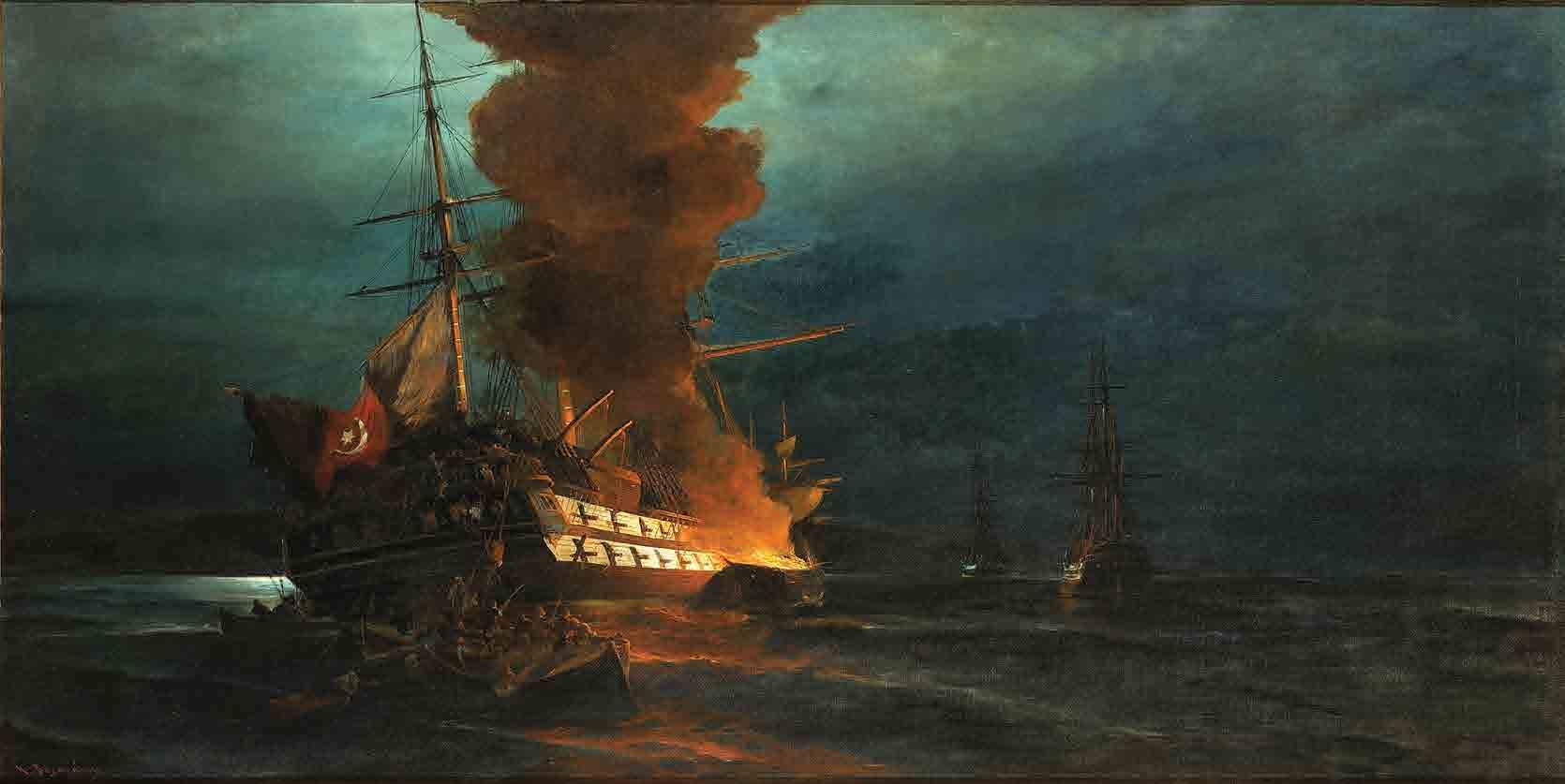
4 3

Oil on canvas.

cm. Aikaterini Laskaridis Foundation P15.
Η πυρπόληση της τουρκικής ναυαρχίδας, 1890-1895. Λάδι σε καµβά 79x114 εκ. Ίδρυµα Αικατερίνης Λασκαρίδη
1890-1895.
P15. ,
79x114

Afrigate with hoisted sails is crossing the turbulent sea. The sailing vessel is tilting sharply and the white-crested waves are crashing violently against a rocky mass. The entire painting has a strong dramatic atmosphere. A deep blue colour is prevalent throughout, in the sky and the sea, while the full moon is shining behind the overcast sky. The moonlight is reflected on the churning wet surface and on the masts, rigging, staysails (triangular sails) and sides, while the rest of the scene is heavily shadowed. The composition is very balanced.
Volanakis loved to paint night landscapes and always rendered them with a particularly dramatic atmosphere. He used colour tones to be able to better express the contrast between light and dark, brightness and shadow. Throughout all periods of his artistic life, he created works with the reflections of the moonlight and the deep darkness of night. It is evident that the difficulty of the pictorial narration, due to the minimal range of colours and the constant changes through chiaroscuro, was seen as a challenge of artistic skill demonstration by the experienced painter.
For example, we mention some of Volanakis’ works depicting night landscapes: from 1869 to 1875 Night fishing of the St. Straight Collection, from 1891 to 1895 Night at the port of Piraeus of the Papalexandris Brothers Collection (52 x 103 cm), from 1896 to 1907 Nocturne of the Bank of Greece (78 x 135 cm), Nocturne of the National Gallery, (27 x 41 cm), Nocturne of the Koutlidis Collection (24 x 44 cm), and a series of works with the theme Nighttime burnings, of the Koutlidis, Konstantinidis and Fragkidis Collection. The collection of the Aikaterini Laskaridis Foundation includes the works: Frigate in the moonlight, Harbour of Volos by moonlight (18901895), Moonlit harbour of Volos (1895-1900), Night seascape, Nocturne, Pyrophani - Fire Fishing, Volos harbour at night, Fishing light, Fishing boats in the moonlight.
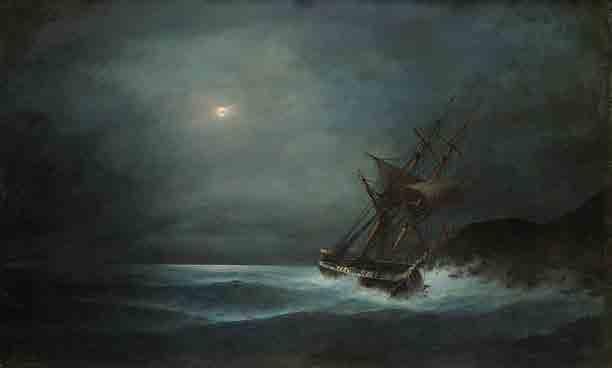


Posidonia 3-7 June 2024 F
Μια φρεγάτα με όρτσα τα πανιά διασχίζει τη φουρτουνιασμένη θάλασσα. Το ιστιοφόρο σκάφος γέρνει έντονα και τα κύματα αφρίζουν και χτυπάνε με ορμή σε έναν βραχώδη όγκο. Όλη η παράσταση έχει έναν έντονα δραματικό χαρακτήρα. Παντού επικρατεί ένα βαθυκύανο χρώμα, σε ουρανό και θάλασσα, ενώ το ολόγεμο φεγγάρι λάμπει πίσω από τον νεφελώδη ουρανό. Το φως της σελήνης αντανακλά στην αγριεμένη υγρή επιφάνεια και πάνω στους ιστούς, τις αρματωσιές, τις στραλιέρες (τα τριγωνικά πανιά) και τις παρειές, ενώ η υπόλοιπη παράσταση είναι έντονα σκιερή. Η σύνθεση είναι εξαιρετικά ισορροπημένη. Ο Βολανάκης αγαπούσε ιδιαίτερα να ζωγραφίζει νυχτερινά τοπία και τα απέδιδε πάντα με μια ιδιαίτερα δραματική ατμόσφαιρα. Χρησιμοποιούσε τις χρωματικές τονικότητες για να μπορεί να εκφράσει περισσότερο την αντίθεση μεταξύ φωτός και σκότους, λάμψης και σκιάς. Σε όλες τις περιόδους της καλλιτεχνικής του ζωής φιλοτέχνησε έργα με τις αντανακλάσεις του φεγγαρόφωτου και το βαθύ σκοτάδι της νύχτας. Είναι προφανές ότι η δυσκολία της ζωγραφικής αφήγησης, με ελάχιστη χρωματική γκάμα και τις συνεχείς εναλλαγές στον σκιοφωτισμό αποτελούσε μια πρόκληση για τον έμπειρο ζωγράφο να αποδείξει τις καλλιτεχνικές δεξιότητές του. Ενδεικτικά αναφέρουμε μερικά έργα του Βολανάκη με νυχτερινά τοπία: από την περίοδο 1869-1875 Το νυχτερινό ψάρεμα της Συλλογής Στ. Στρέιτ, από την περίοδο 1891-1895 Νύχτα στο λιμάνι του Πειραιά, Συλλογή Αδελφών Παπαλεξανδρή (52x103 εκ.), από την περίοδο 1896-1907 Το Νυχτερινό της Τράπεζας της Ελλάδος (78x1,35 εκ.), Το Νυχτερινό της Εθνικής Πινακοθήκης, (27x41 εκ.), Το Νυχτερινό της Συλλογής Κουτλίδη (24x44 εκ.), και μια σειρά έργων με θέμα «Νυχτερινές πυρπολήσεις», της Συλλογής Κουτλίδη, Κωνσταντινίδη, Φραγκίδη. Στη συλλογή του Ιδρύματος Αικατερίνης Λασκαρίδη ανήκουν τα έργα: Η φρεγάτα στο φεγγαρόφωτο, Το λιμάνι του Βόλου με φεγγαρόφωτο (1890-1895), Το λιμάνι του Βόλου με φεγγαρόφωτο (1895-1900), Νυχτερινή Θαλασσογραφία, Το νυχτερινό, Ψάρεμα με πυροφάνι, Το λιμάνι του Βόλου τη νύχτα, Το πυροφάνι, Ψαρόβαρκες στο φεγγαρόφωτο.


74


The detonation of the Turkish warship with two rows of cannons on May 27, 1821, in Eressos of Mytilene, by Dimitrios Papanikolis, a native of Psara, is a milestone event of the Greek War of Independence. Since then, the use of fire ships by Greeks in naval operations became a common practice. Eyewitnesses vividly report that the deafening noise and the tall flames tha t rose into the sky terrorized the Turks and boosted the morale of the Greeks. The monumental composition is dominated by the destruction of the large ship and the dramatic agony of the shipwrecked. Its structure is modeled after works by Géricault and Delacroix. Volanakis painted the piece in 1882 while still in Munich, as indicated by his use of the Latin signature C. Bolanachi.
75
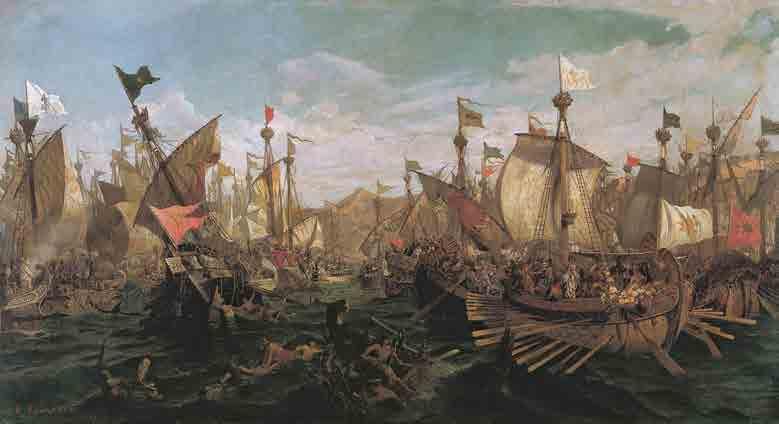
Awork of 1882, the Naval Battle of Salamis, in the Headquarters of the Hellenic Navy, along with the Burning of the Turkish brigate at Eressos, of 1882, in the Hellenic Maritime Museum, constitute the epic diptych of the end of the painter’s German period. The two works present interesting contemplations, introduce new elements, reshape and renegotiate the older ones. At Salamis he depicts the most crucial phase of the battle: the combat of the Greek and Persian triremes. The structure of the representation is defined by two arcs facing each other, the roots of which lie in the upper and lower extremities of the painting, while their chords tend to collide in the middle. The two arcs encompass the fleets of the opponents, while in the triangles that remain open we see integrated: above, the ridge of Mt Aegaleo, and, below, shipwreck relics with the stranded at sea. Emphatic emerges the sense of explosive outburst with which the work is imbued and which is conveyed by successive curves of the sails and tilting of the masts towards the centre or the edges of the painting. Beautifully, moreover, have been rendered the zigzag outlines of the masts, the currents of the wind and the intertwined axes. Nevertheless, the dynamism and commotion of the upper part is not sufficiently transmitted to the lower one, where, primarily, the action is unfolding. The figures of the warriors are not clearly discernible neither are particularly kinetic. The calmness of the horizontal axes, despite the spectacular
76
ργο του 1882, η Ναυμαχία της Σαλαμίνας, Αρχηγείο Ναυτικού, συνιστά με την Πυρπόληση του τουρκικού δικρότου στην Ερεσό, 1882, Ναυτικόν Μουσείον της Ελλάδος, το επικό δίπτυχο του τέλους της γερμανικής περιόδου. Τα δύο έργα παρουσιάζουν ενδιαφέροντες προβληματισμούς, εισάγουν νέα στοιχεία, αναπλάθουν και επεξεργάζονται τα παλαιότερα. Στη Σαλαμίνα απεικονίζεται η κρισιμότερη φάση της μάχης: η σύρραξη των ελληνικών και περσικών τριήρων. Η δομή της παράστασης ορίζεται από δύο τόξα στραμμένα αντίθετα μεταξύ τους, των οποίων οι γενέσεις βρίσκονται στα άνω και κάτω άκρα του πίνακα, ενώ οι χορδές τους τείνουν να συγκρουσθούν στο μέσον. Τα δύο τόξα περιλαμβάνουν τους στόλους των αντιπάλων, ενώ στα τρίγωνα που απομένουν ελεύθερα εντάσσονται: άνω, οι κορυφογραμμές του Αιγάλεω, και, κάτω, τα συντρίμμια με τους ναυαγούς. Εμφατική διαγράφεται η έξαρση που διαπνέει το έργο και η οποία εκφράζεται με επαναλαμβανόμενες καμπύλες των πανιών και κλίση των ιστών προς το κέντρο ή τα άκρα του πίνακα. Καλά, επίσης, έχουν αποδοθεί οι τεθλασμένες των ιστίων, τα ρεύματα του ανέμου και οι συμπλεκόμενοι άξονες. Εντούτοις, ο δυναμισμός και η σύγχυση του άνω μέρους δεν μεταδίδεται επαρκώς στο κάτω, όπου, κυρίως, εξελίσσεται η δράση. Οι μορφές των πολεμιστών δεν είναι ευδιάκριτες ούτε ιδιαίτερα κινητικές. Η ηρεμία των οριζόντιων αξόνων, παρά τη


destruction of the ships and the agonizing efforts of the stranded in the waves, does little to denote the fever of the
The concept of clash is suggested, the impression, though, of battle is not clear-cut. The representation could also be considered as depicting a storm that caused destruction. Responsible, to a great extent, for the lack of unity is the unexpected tranquility that prevails in the trireme to the right, which is given prominence more than any other ship. On the stern, under a large canopy, surrounded by flowers, with her maids and her personal guard around her, a woman is sitting.
Obviously a noblewoman, in whose service are both the ship and the fighters. Incompatible with her undisturbed stance is the violent episode in which she has been involved, occurring certainly after her order: the prow of her ship has rammed the side of a passing enemy ship.
After all this, I think, it is not difficult to define the identity of the woman. It is Artemisia, queen of Caria, who had come to Salamis as an ally of Xerxes, but did not hesitate, when she realized what the outcome of the battle was going to be, to turn her ship against a Persian one, sink it and escape the encirclement of the Greek ones (Herodotus, Histories, VII, 99, VIII, 87-89).
Almost completely at odds with her energetic character but also with the turmoil of the battle is the composure she maintains in the depiction. Also, the royal trireme, as the other ships, too, betray historical inaccuracies among the immediately obvious ones being the flying sails –it is known that in battle the masts are removed from their base– as to the baskets up the masts these are considerably later features than the naval battle.
Volanakis is aware, probably, of the inaccuracies, but this does not stop him from proceeding. He thinks more as an artist, with a partiality for colour and ornamentation and less as a historian researcher. He uses, therefore, false elements, which, though, will enhance the impression, such as the abundant signs at the top of the masts, the billowing sails, the broken masts. In any case, it is not possible to attribute the representation to any other historical scene for two reasons: first, the painting was a state commission, as a result its theme had been explicitly defined, second, Volanakis is invited to the palace to show to the king the painting, which is specifically referred to as Naval Battle of Salamis.
Relevant is the issue of the direct or indirect influences. It would suffice to mention one probable source of influence: Volanakis knows the Naval Battle of Salamis by Wilhelm von Kaulbach: he has seen it both in a Munich Pinakothek and in the International Exhibition of 1869. It is very fortunate that he did not choose to imitate it. On the German painting the bravura of an artist is shown, to whom no one can deny the audacity of imagination and its masterful exploitation. His Naval Battle unfolds in an imaginary sea area, where gods get involved, mythical heroes and men, among whom also Xerxes, furious, watches the destruction of his fleet. The violence and the unlimited imagination do not take us by surprise, they are expected and acceptable, what is disturbing is the empty theatricality and elaboration.
destruction of the ships and the agonizing efforts of the stranded in the waves, does little to denote the fever of the battle.
The concept of clash is suggested, the impression, though, battle is not clear-cut. The representation could also be considered as depicting a storm that caused destruction. Responsible, to a great extent, for the lack of unity is the unexpected tranquility that prevails in the trireme to the right, which is given prominence more than any other ship.
On the stern, under a large canopy, surrounded by flowers, with her maids and her personal guard around her, woman is sitting.
Obviously a noblewoman, in whose service are both the ship and the fighters. Incompatible with her undisturbed stance is the violent episode in which she has been involved, occurring certainly after her order: the prow her ship has rammed the side of a passing enemy ship.
After all this, I think, it is not difficult to define the identity of the woman. It is Artemisia, queen of Caria, who had come to Salamis as an ally of Xerxes, but did not hesitate, when she realized what the outcome of the battle was going to be, to turn her ship against a Persian one, sink it and escape the encirclement of the Greek ones (Herodotus, Histories, VII, 99, VIII, 87-89).
Almost completely at odds with her energetic character but also with the turmoil of the battle is the composure she maintains in the depiction. Also, the royal trireme, as the other ships, too, betray historical inaccuracies among the immediately obvious ones being the flying sails –it known that in battle the masts are removed from their base– as to the baskets up the masts these are considerably later features than the naval battle.
Volanakis is aware, probably, of the inaccuracies, but this does not stop him from proceeding.
He thinks more as an artist, with a partiality for colour and ornamentation and less as a historian researcher. He uses, therefore, false elements, which, though, will enhance the impression, such as the abundant signs at the top of the masts, the billowing sails, the broken masts.
In any case, it is not possible to attribute the representation to any other historical scene for two reasons: first, the paint ing was a state commission, as a result its theme had been explicitly defined, second, Volanakis is invited to the palace to show to the king the painting, which is specifically referred to as Naval Battle of Salamis.
Relevant is the issue of the direct or indirect influences. would suffice to mention one probable source of influence: Volanakis knows the Naval Battle of Salamis by Wilhelm von Kaulbach: he has seen it both in a Munich Pinakothek and in the International Exhibition of 1869. It is very fortu nate that he did not choose to imitate it. On the German painting the bravura of an artist is shown, to whom no one can deny the audacity of imagination and its masterful exploitation. His Naval Battle unfolds in an imaginary sea area, where gods get involved, mythical heroes and men, among whom also Xerxes, furious, watches the destruction of his fleet. The violence and the unlimited imagination do not take us by surprise, they are expected and acceptable, what is disturbing is the empty theatricality and elabora tion. to an mythical
77
θεαματική καταστροφή των καραβιών και τις αγωνιώδεις προσπάθειες των ναυαγών στα κύματα, ελάχιστα δηλώνει τον πυρετό της μάχης. Η ιδέα της σύγκρουσης υποβάλλεται, όμως η εντύπωση της μάχης δεν είναι σαφής. Η παράσταση θα μπορούσε να θεωρηθεί και θύελλα που προκάλεσε την καταστροφή. Την ευθύνη, κατά μέγα μέρος, για την έλλειψη ενότητας φέρει η απροσδόκητη ηρεμία που επικρατεί στην τριήρη δεξιά και η οποία προβάλλεται περισσότερο από κάθε άλλο πλοίο. Στην πρύμη, κάτω από μεγάλη τέντα, πλαισιωμένη από λουλούδια, με τις θεραπαινίδες και την προσωπική της φρουρά γύρω της, κάθεται μια γυναίκα. Προφανώς αρχόντισσα, στην υπηρεσία της οποίας είναι και το πλοίο και οι μαχητές. Ασυμβίβαστο με την ατάραχη στάση της είναι το βίαιο επεισόδιο στο οποίο έχει εμπλακεί, ασφαλώς έπειτα από διαταγή της: η πλώρη του πλοίου της έχει σφηνωθεί στην πλευρά διερχόμενου εχθρικού πλοίου. Έπειτα από αυτά, νομίζω, ότι δεν είναι δύσκολο να καθοριστεί η ταυτότητα της γυναίκας. Πρόκειται για την Αρτεμισία, βασίλισσα της Καρίας, η οποία είχε προσέλθει στη Σαλαμίνα ως σύμμαχος του Ξέρξη, αλλά δεν δίστασε, όταν αντελήφθη ποια θα ήταν η έκβαση της μάχης, να στρέψει το πλοίο της εναντίον ενός περσικού, να το βυθίσει και να διαφύγει από τον κλοιό των ελληνικών (Ηροδότου, Ιστορίαι, VII, 99, VIII, 87-89). Προς τον ενεργητικό χαρακτήρα της αλλά και προς τον σάλο της μάχης ελάχιστα συμβιβάζεται η αταραξία με την οποία απεικονίζεται. Επίσης, η βασιλική τριήρης, όπως και άλλα πλοία, προδίδουν ιστορικές ανακρίβειες από τις αμέσως ελεγχόμενες είναι τα αναπεπταμένα ιστία –είναι γνωστό ότι κατά τη μάχη οι ιστοί αφαιρούνται από τη βάση τους– τα δε κοφίνια στο ύψος των ιστών είναι αρκετά μεταγενέστερα της ναυμαχίας. Ο Βολανάκης γνωρίζει, πιθανώς, την ανακρίβεια, αλλά αυτό δεν τον εμποδίζει να προχωρήσει. Σκέπτεται περισσότερο ως καλλιτέχνης, με ροπή προς το χρώμα και την κόσμηση και λιγότερο ως ερευνητής ιστορικός. Χρησιμοποιεί, ως εκ τούτου, στοιχεία αναληθή, τα οποία όμως θα ισχυροποιήσουν την εντύπωση, όπως τα άφθονα σήματα στην κορυφή των ιστών, τα φουσκωμένα πανιά, οι σπασμένοι ιστοί. Εξάλλου δεν είναι δυνατόν να αποδοθεί η παράσταση σε άλλη ιστορική σκηνή για δύο λόγους: πρώτον, ο πίνακας υπήρξε κρατική παραγγελία, επομένως το θέμα του έχει καθοριστεί επακριβώς, δεύτερον, ο Βολανάκης καλείται στα ανάκτορα να επιδείξει στον βασιλέα τον πίνακα, ο οποίος ρητά αναφέρεται ως Ναυμαχία της Σαλαμίνας. Συναφές είναι το ζήτημα των άμεσων ή έμμεσων επιδράσεων. Αρκούμαι στην πιθανότητα μιας και μόνο: ο Βολανάκης γνωρίζει τη Ναυμαχία της Σαλαμίνος του Wilhelm von Kaulbach: την έχει δει και σε Πινακοθήκη του Μονάχου και στη Διεθνή Έκθεση του 1869. Είναι ευτύχημα ότι δεν θέλησε να τη μιμηθεί. Στον γερμανικό πίνακα επιδεικνύεται η bravura ενός καλλιτέχνη, στον οποίο δεν μπορεί κανείς να αρνηθεί την τόλμη της φαντασίας και τη δεξιοτεχνική της εκμετάλλευση. Η Ναυμαχία του εκτυλίσσεται σε ένα φανταστικό θαλάσσιο χώρο, όπου αναμιγνύονται θεοί, μυθικοί ήρωες και άνθρωποι, μεταξύ των οποίων, έξαλλος, και ο Ξέρξης να παρακολουθεί την καταστροφή του στόλου του. Η βία και η ασυδοσία της φαντασίας δεν εκπλήσσουν είναι αναμενόμενα και ανεκτά αυτό που ενοχλεί είναι η κενή θεατρικότητα και η επιτήδευση.

78 Η Ναυµαχία του Ναβαρίνου κατά Garneray. Λάδι σε µουσαµά 110x150 εκ. Συλλογή Πολεµικού Ναυτικού.
The Battle of Navarino by Garneray. Oil on canvas, 110x150 cm.


Η
79
180
210 4516264, 210 4516822, Fax: 210 4512277E-mail: info@hmmuseum.gr www.hmmuseum.gr
22980 52355, 54142, Fax: 22980 52355, E-mail: www.iamy.gr
22860 71156
26950 83223/28249, Fax: 26950 83748
: 22890 22700/210 81 25 547, Fax: 22890 22700, E-mail: museum@emproslines com
2282 0 22275, 2282 360223, Fax: 2282024166, E-mail: npdd@andros.gr
ΝΑΥΤΙΚΟ
00357 23816366, Fax: 003523816369, E-mail:
και Fax: 24270 23504, E-mail:
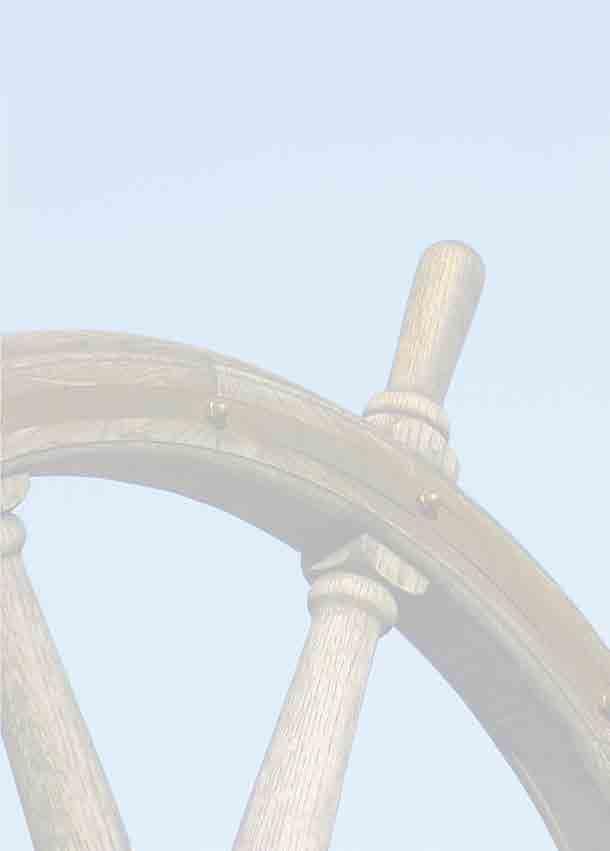
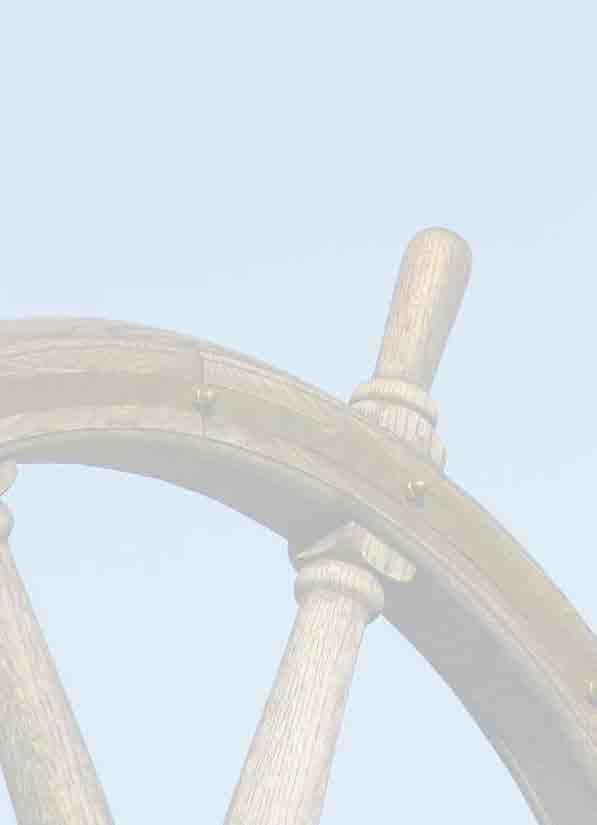
ΝΑΥΤΙΚA MOYΣΕΙΑ ΝΑΥΤΙΚΟ ΜΟΥΣΕΙΟ ΕΛΛΑΔΟΣ
Ακτή Θεμιστοκλέους,
Μαρίνα Ζέας-Πειραιάς, Τηλ:
ΝΑΥΤΙΚΟ ΜΟΥΣΕΙΟ ΚΡΗΤΗΣ
Ακτή Κουντουριώτη,
33 Χανιά, Τηλ:
ΝΑΥΤΙΚΟ ΚΑΙ ΙΣΤΟΡΙΚΟ ΜΟΥΣΕΙΟ ΓΑΛΑΞEΙΔΙΟΥ (Δημοτικό) Μουσείου 3 & Σταύρου Νιάρχου, 330 52 Γαλαξείδι, Τηλ/Fax: 22650 41795 ΙΣΤΟΡΙΚΟ ΑΡΧΕΙΟ - ΜΟΥΣΕΙΟ ΥΔΡΑΣ (ΥΠ.ΕΘ.Π.Θ- ΓΕΝΙΚΑ ΑΡΧΕΙΑ ΤΟΥ ΚΡΑΤΟΥΣ)
(Ν.Π.Ι.Δ.)
185 37
(Ν.Π.Ι.Δ.)
731
28210 91875, Fax: 28210 74484, E-mail: www.mar-mus- .gr
40 ΥΔΡΑ, Τηλ:
ΝΑΥΤΙΚΟ ΜΟΥΣΕΙΟ-Θ/Κ «Γ. ΑΒΕΡΩΦ» (Κρατικό) Α/Τ ΒΕΛΟΣ (Κρατικό) Μουσείο Αντιδικτατορικού Αγώνα, Μαρίνα Φλοίσβου, Τροκαντερό, 175 10 Παλαιό Φάληρο, Τηλ: 210 9888457 ΔΗΜΟΤΙΚΟ ΝΑΥΤΙΚΟ ΚΑΙ ΛΑΟΓΡΑΦΙΚΟ ΜΟΥΣΕΙΟ ΣΥΜΗΣ 856 00 Γιαλός Σύμης, Δωδεκάνησα, Τηλ: 22460 72363, 22460 72569 ΜΟΥΣΕΙΟ ΑΛΙΕΙΑΣ ΚΑΙ ΝΑΥΠΗΓΙΚΗΣ ΑΛΙΕΥΤΙΚΩΝ ΣΚΑΦΩΝ ΤΟΥ Δ. ΠΕΡΑΜΑΤΟΣ (Δημοτικό) Λ. Δημοκρατίας & Μ. Κιουρί (δίπλα στα Τ.Ε.Ε), 188 63 Ν. Ικόνιο, Πέραμα, Τηλ. 210 4014896, 210 4414700 ΜΟΥΣΕΙΟ ΑΛΙΕΥΤΙΚΩΝ ΣΚΑΦΩΝ & ΕΡΓΑΛΕΙΩΝ Ν. ΜΟΥΔΑΝΙΩΝ ΧΑΛΚΙΔΙΚΗΣ (Δημοτικό) Βιθυνίας 2, 632 00 Ν. Μουδανιά Χαλκιδικής, Τηλ/Fax: 23730 26166, E-mail: ΜΟΥΣΕΙΟ ΝΑΥΤΙΚΗΣ ΠΑΡΑΔΟΣΗΣ (Αστική μη κερδοσκοπική εταιρία) ΜΟΥΣΕΙΟ ΝΑΥΤΙΚΗΣ ΠΑΡΑΔΟΣΗΣ ΚΑΙ ΣΠΟΓΓΑΛΕΙΑΣ ΝΕΑΣ ΚΟΥΤΑΛΗΣ (Δημοτικό) ΝΑΥΤΙΚΟ ΚΑΙ ΙΣΤΟΡΙΚΟ ΜΟΥΣΕΙΟ ΖΑΚΥΝΘΟΥ
Μπόχαλη, Σταυρός,
Ζάκυνθος, Τηλ.:
ΜΙΛΑΝΕΙΟ ΝΑΥΤΙΚΟ ΜΟΥΣΕΙΟ Τσιλιβή, Ζακύνθου ΤΤ 22100. Τηλ. 26950 42436/ Κιν. 6974 065 776 ΝΑΥΤΙΚΟ - ΛΑΟΓΡΑΦΙΚΟ ΜΟΥΣΕΙΟ ΙΘΑΚΗΣ (Δημοτικό) Πρώην Ηλεκτρικός Σταθμός, Βαθύ Ιθάκης, Τηλ.
ΝΑΥΤΙΚΟ ΜΟΥΣΕΙΟ ΑΙΓΑΙΟΥ (Ν.Π.Ι.Δ) Ενόπλων Δυνάμεων
Μύκονος, Τηλ
ΝΑΥΤΙΚΟ ΜΟΥΣΕΙΟ ΑΝΔΡΟΥ (Δημοτικό) Δήμος Άνδρου,
Χώρα Άνδρου, Τηλ:
ΝΑΥΤΙΚΟ ΜΟΥΣΕΙΟ ΘΗΡΑΣ (Ν.Π.Ι.Δ) Οία Θήρας,
Τηλ.:
ΠΛΩΤΟ
(Ν.Π.Ι.Δ.)
29100
2674033398
10, 846 00
845 00
847 00,
ΜΟΥΣΕΙΟ ΙΟΝΙΟΥ
Δημοτικό Διαμέρισμα Φάρσων Δήμου Αργοστολίου, 28100 Φάρσα Κεφαλληνίας, Τηλ: 26710
ΝΑΥΤΙΚΟ ΜΟΥΣΕΙΟ ΚΑΒΑΛΑΣ (Δημοτικό) Ραψάνη, Χρυσοστόμου Σμύρνης 1, Τηλ: 2510 240 668, 6977 391 605, Ε-mail: nmkav.gr@gmail.com ΝΑΥΤΙΚΟ ΜΟΥΣΕΙΟ ΚΑΛΥΜΝΟΥ (Δημοτικό) Δήμος Καλύμνου, 852 00 Κάλυμνος, Τηλ: 2243 0 51361 ΜΟΥΣΕΙΟ ΝΑΥΠΗΓΙΚΩΝ ΚΑΙ ΝΑΥΤΙΚΩΝ ΤΕΧΝΩΝ ΑΙΓΑΙΟΥ (υπό ίδρυση) Πληροφορίες: Πνευματικό Ίδρυμα Σάμου "Νικόλαος Δημητρίου" Τηλ.: 22730 62286 ΝΑΥΤΙΚΟ ΜΟΥΣΕΙΟ ΚΑΡΔΑΜΥΛΩΝ ΧΙΟΥ (υπό ίδρυση) Καρδάμυλα 82 300 Χίος, Τηλ. Πληροφοριών: 2510835287/ Κιν.: 6936136145 ΝΑΥΤΙΚΟ ΜΟΥΣΕΙΟ ΛΙΤΟΧΩΡΟΥ (Ν.Π.Ι.Δ.) Αγ. Νικολάου 15, 60200 Λιτόχωρο Πιερίας, Τηλ. 2352082711, E-mail: ΝΑΥΤΙΚΟ ΜΟΥΣΕΙΟ ΟΙΝΟΥΣΣΩΝ (Ν.Π.Ι.Δ) E-mail: elachl@gmail.com ΝΑΥΤΙΚΟ ΜΟΥΣΕΙΟ ΧΙΟΥ (Ν.Π.Ι.Δ) Στέφανου Τσουρή 20, 821 00 Χίος, Τηλ: 22710 44139, Fax: 22710 44141, E-mail: : www .gr ΜΟΥΣΕΙΟ ΝΑΥΤΙΚΗΣ ΚΑΙ ΠΟΛΙΤΙΣΤΙΚΗΣ ΠΑΡΑΔΟΣΗΣ ΣΚΙΑΘΟΥ Παλιό Λιμάνι, Σκιάθος 37 002, Τηλ
ΛΑΟΓΡΑΦΙΚΟ & ΝΑΥΤΙΚΟ ΜΟΥΣΕΙΟ ΣΑΛΑΜΙΝΑΣ
Κων/νου Καραμανλή 1, Δημαρχιακό Μέγαρο, ΤΤ18900, Σαλαμίνα. Τηλ.-fax: 213-2027316 E-mail: museum@0165.syzefxis.gov.gr ΜΟΥΣΕΙΟ ΝΑΥΤΙΚΉΣ ΠΑΡΑΔΟΣΗΣ ΣΥΡΟΥ (Ν.Π.Ι.Δ.) Ν ΑΥ ΤΙΚΑ Μ ΟΥΣΕΙΑ ΚΑΙ Π ΟΛΙΤΙΣΤΙΚΟΙ Φ ΟΡΕΙΣ ΤΗΣ Ν ΑΥ ΤΙΚΗΣ Π ΑΡΑΔΟΣΗΣ ΣΥΝΕΡΓΑΖΟΜΕΝΑ ΝΑΥΤΙΚA MOYΣΕΙΑ ΔΗΜΟΤΙΚΟ ΜΟΥΣΕΙΟ ΑΓΙΑΣ ΝΑΠΑΣ ‘’THALASSA’’ Κρυού Νερού 14, 30707Αγία Νάπα,Κύπρος, Τηλ.
Φ ΟΡΕΙΣ (Ι ΔΡΥΜΑΤΑ - Ι ΝΣΤΙΤΟΥΤΑ - Ν ΑΥ ΤΙΚΕΣ Σ ΥΛΛΟΓΕΣ ) ΙΔΡΥΜΑ ΑΛΣΟΥΣ ΕΛΛΗΝΙΚΗΣ ΝΑΥΤΙΚΗΣ ΠΑΡΑΔΟΣΗΣ (Ν.Π.Ι.Δ.) Παπαρηγοπούλου 2, 105 61 Αθήνα, Τηλ. 2103368517, Fax:
E-mail:info@ .gr : www. .gr ΙΔΡΥΜΑ «ΑΙΚΑΤΕΡΙΝΗ ΛΑΣΚΑΡΙΔΗ» - ΝΑΥΤΙΚΗ ΣΥΛΛΟΓΗ 2ας Μεραρχίας 36 & Ακτής Μουτσοπούλου, 185 35 Πειραιάς, Τηλ: 210 4297 540-1-2,
210 4296024,
info@laskaridou gr sillogi ΕΛΛΗΝΙΚΟ ΙΝΣΤΙΤΟΥΤΟ ΠΡΟΣΤΑΣΙΑΣ ΝΑΥΤΙΚΗΣ ΠΑΡΑΔΟΣΗΣ (Ν.Π.Ι.Δ.) Σκρα 94, 176 73 Καλλιθέα, Αθήνα, Τηλ. 2108957234 ΙΔΡΥΜΑ ΜΑΡΙΑ ΤΣΑΚΟΣ - ΔΙΕΘΝΕΣ ΚΕΝΤΡΟ ΝΑΥΤΙΚΗΣ ΕΡΕΥΝΑΣ ΚΑΙ ΠΑΡΑΔΟΣΗΣ Μιχαήλη Λιβανού 51, 82100 Χίος, Τηλ: 22710 82777, Fax: 22710 81979, E-mail: @ .gr ΙΝΣΤΙΤΟΥΤΟ ΙΣΤΟΡΙΑΣ ΕΜΠΟΡΙΚΗΣ ΝΑΥΤΙΛΙΑΣ Γρηγορίου Λαμπράκη 154, 185 33 Πειραιάς, Τηλ: 2104191358, 2104297616, Fax: 2104281665, E-mail: museum@yen gr ΝΑΥΤΙΚΟ ΜΟΥΣΕΙΟ ΤΕΧΝΗΣ & ΠΑΡΑΔΟΣΗΣ "ΑΕΙΝΑΥΤΕΣ" Πούντα Ζέζα, Λαύριο, Τηλ.: 210 4133709
(Ν.Π.Ι.Δ.)
87260, Fax: 26710 25656
(Ν.Π.Δ.Δ.)
2103253680,
Fax:
E-mail:
















































































































































